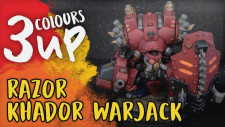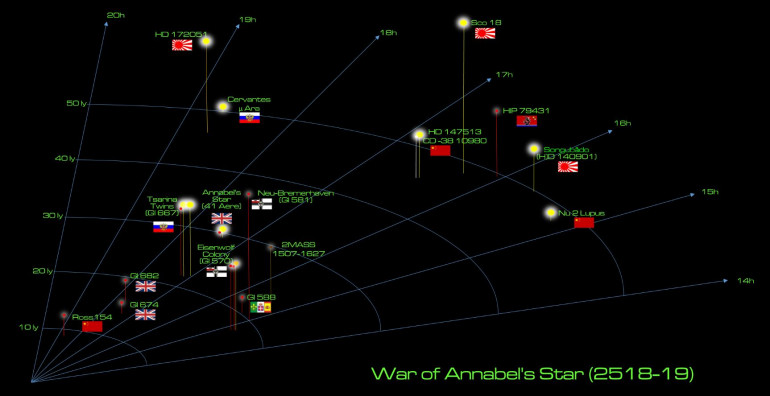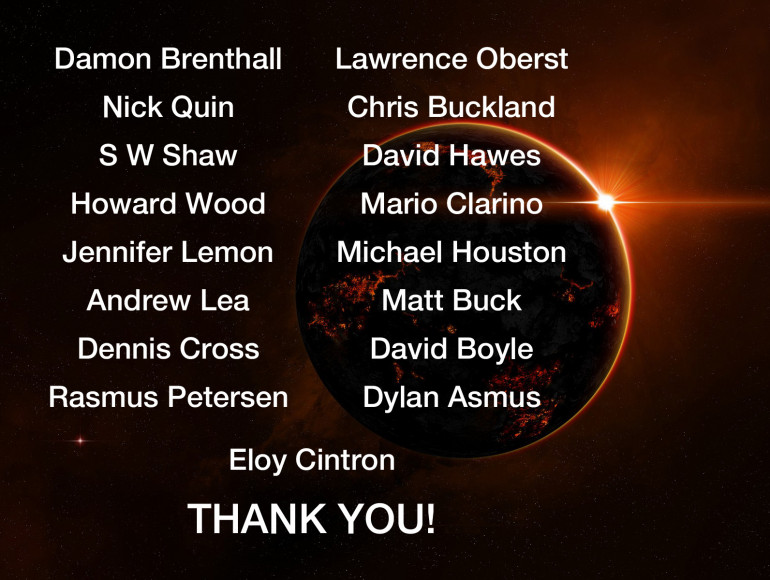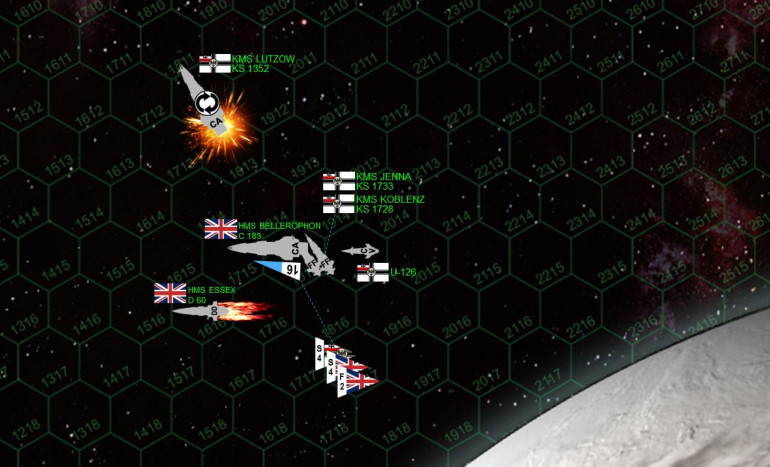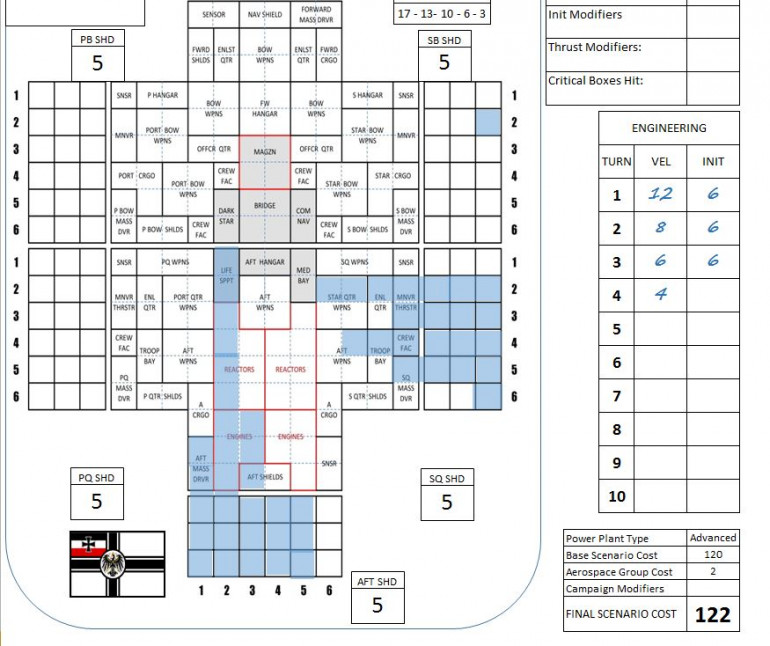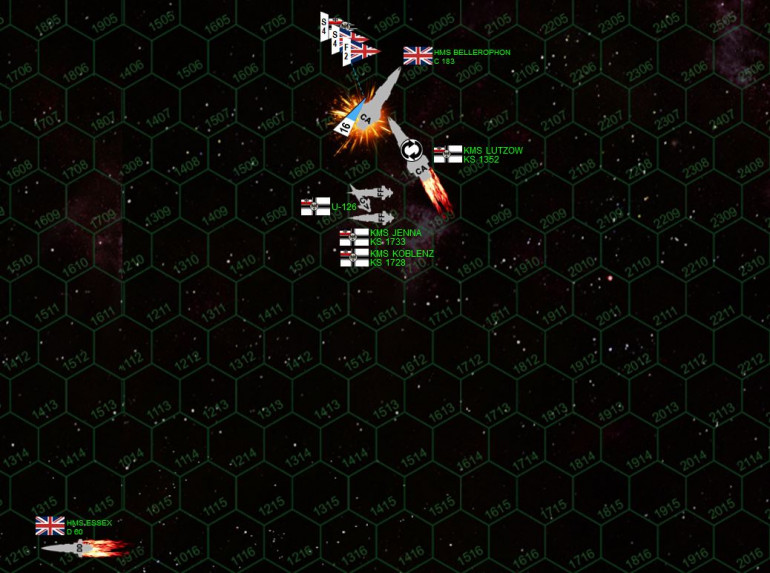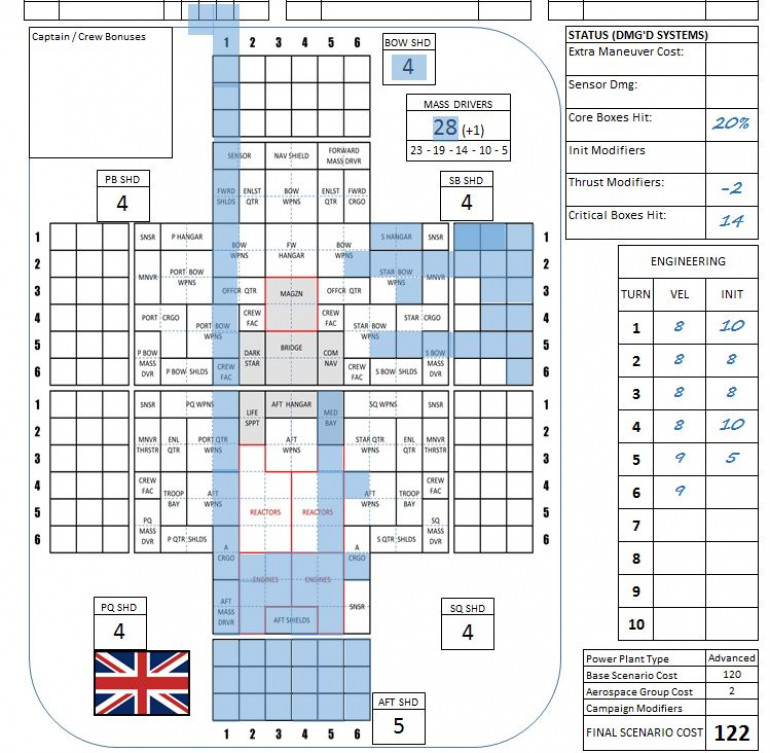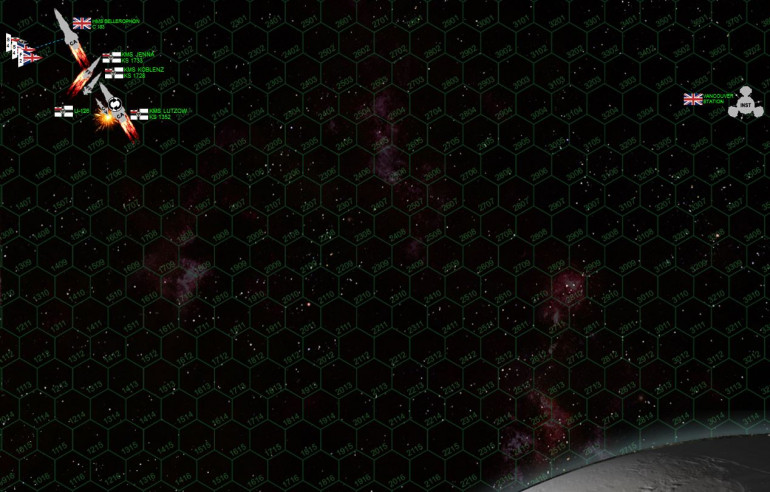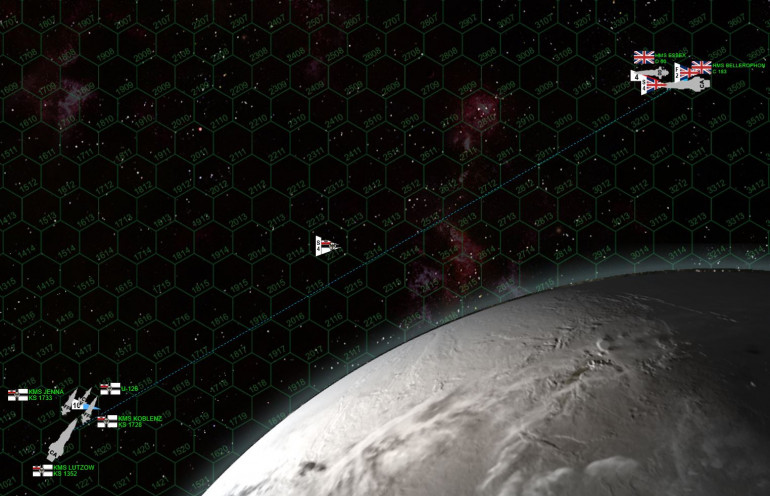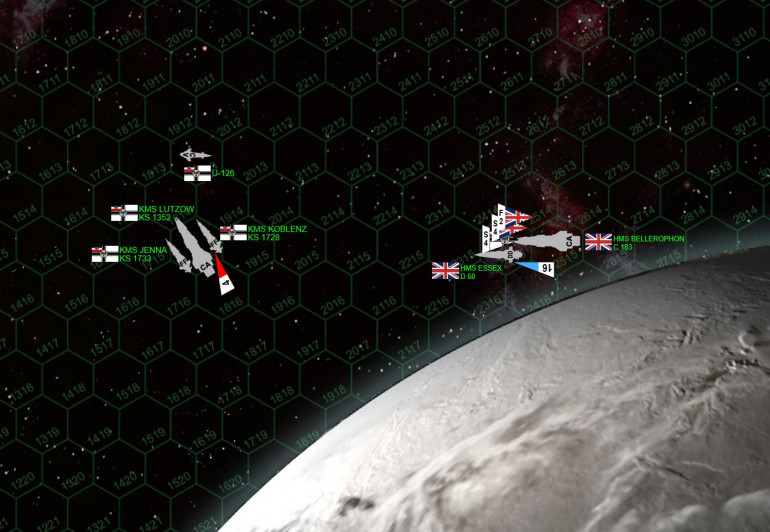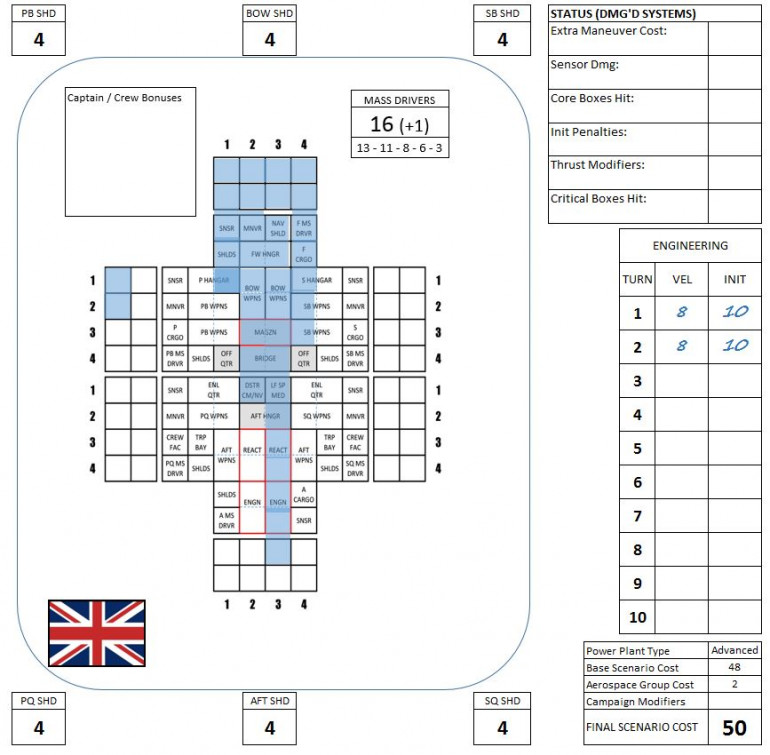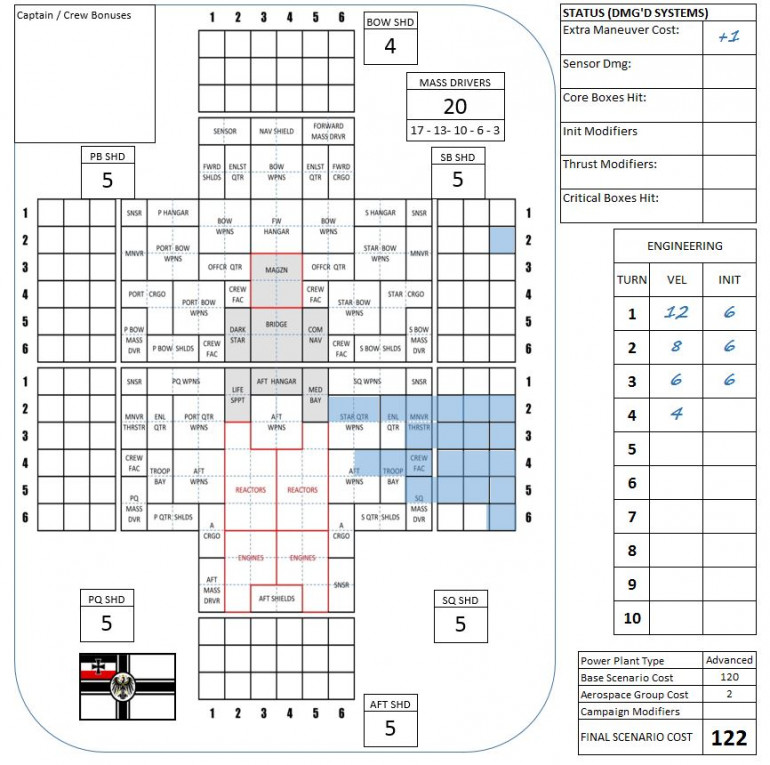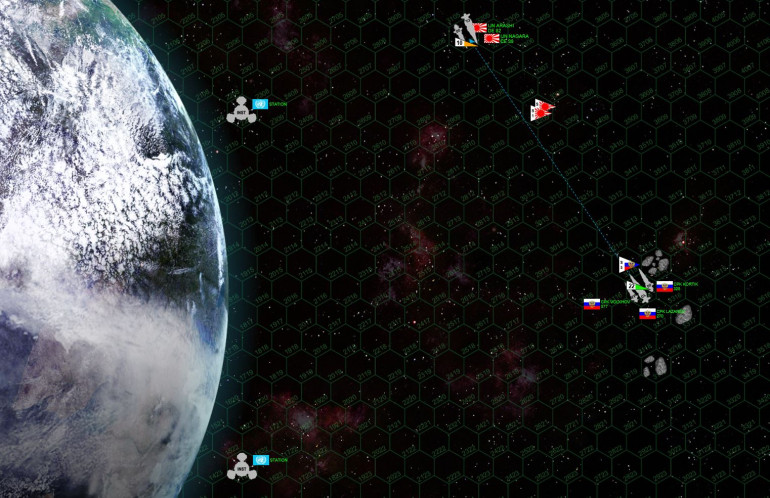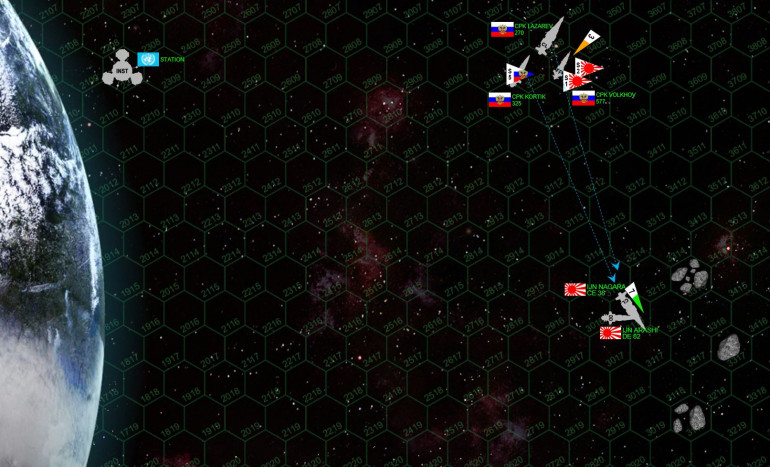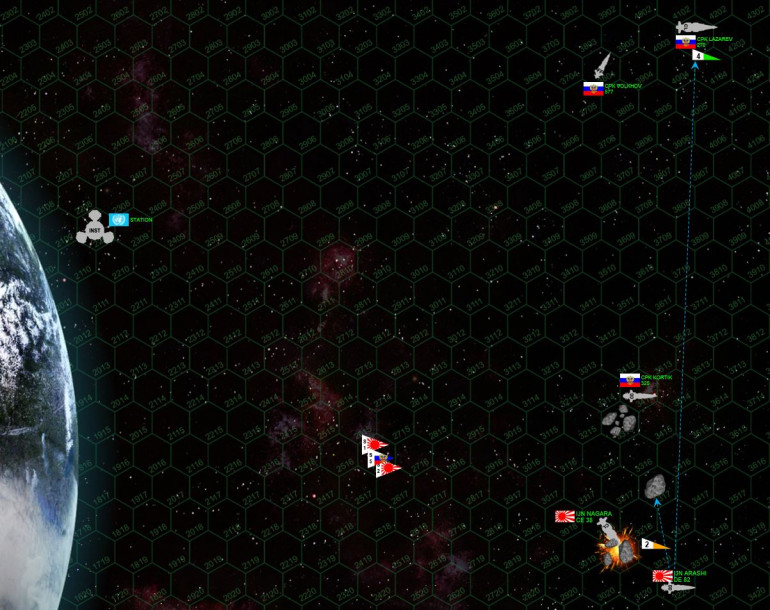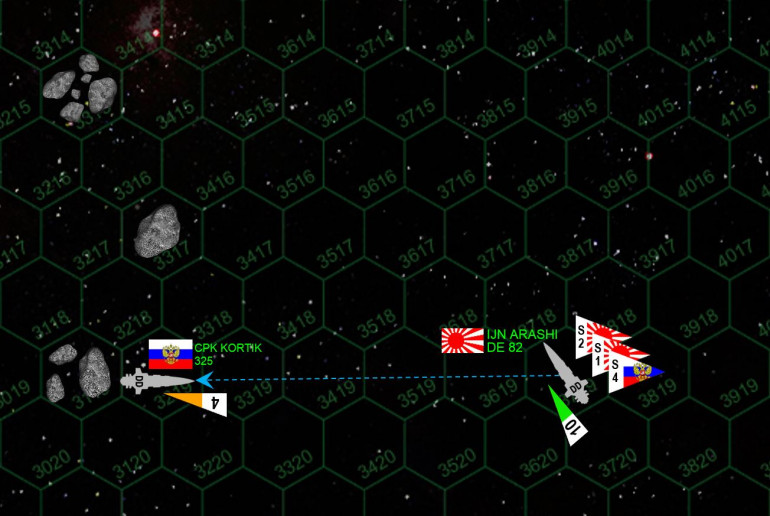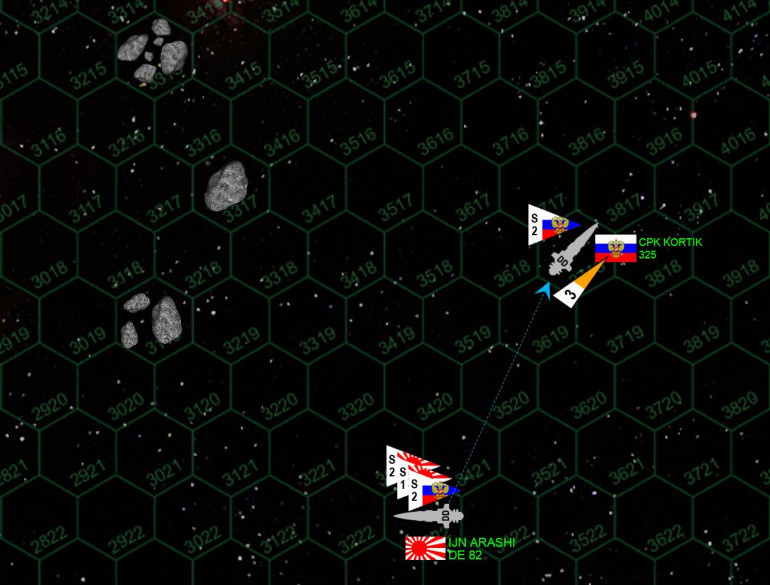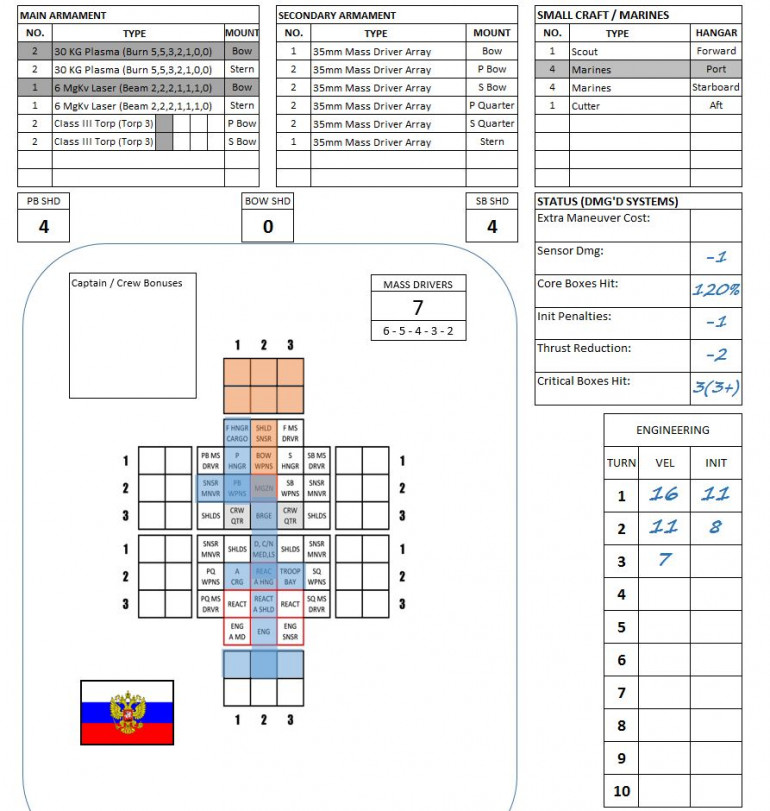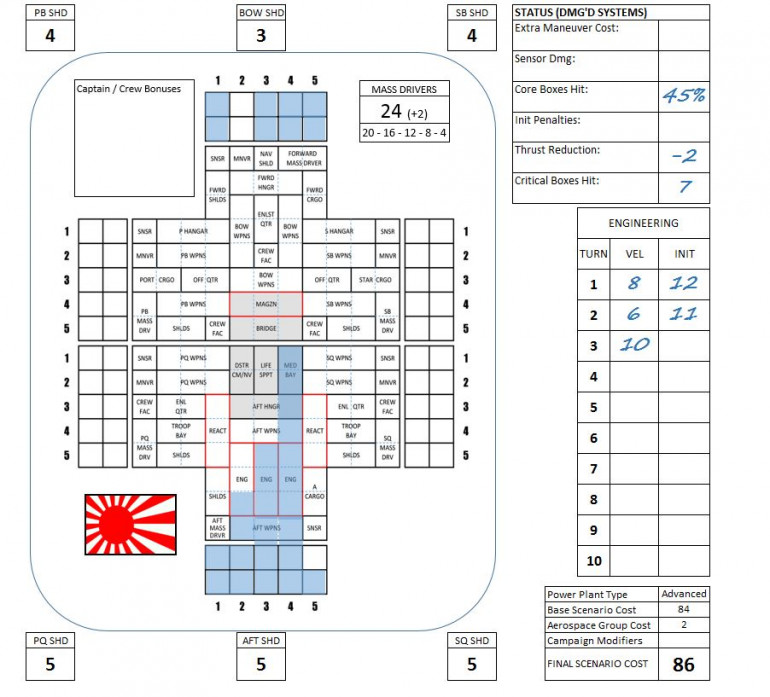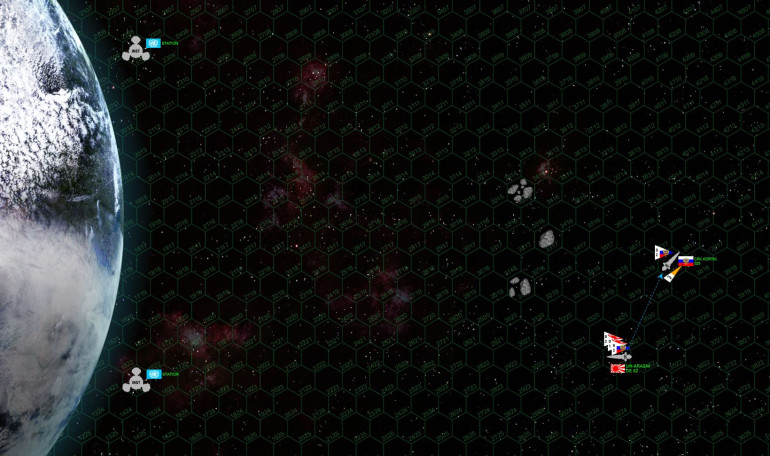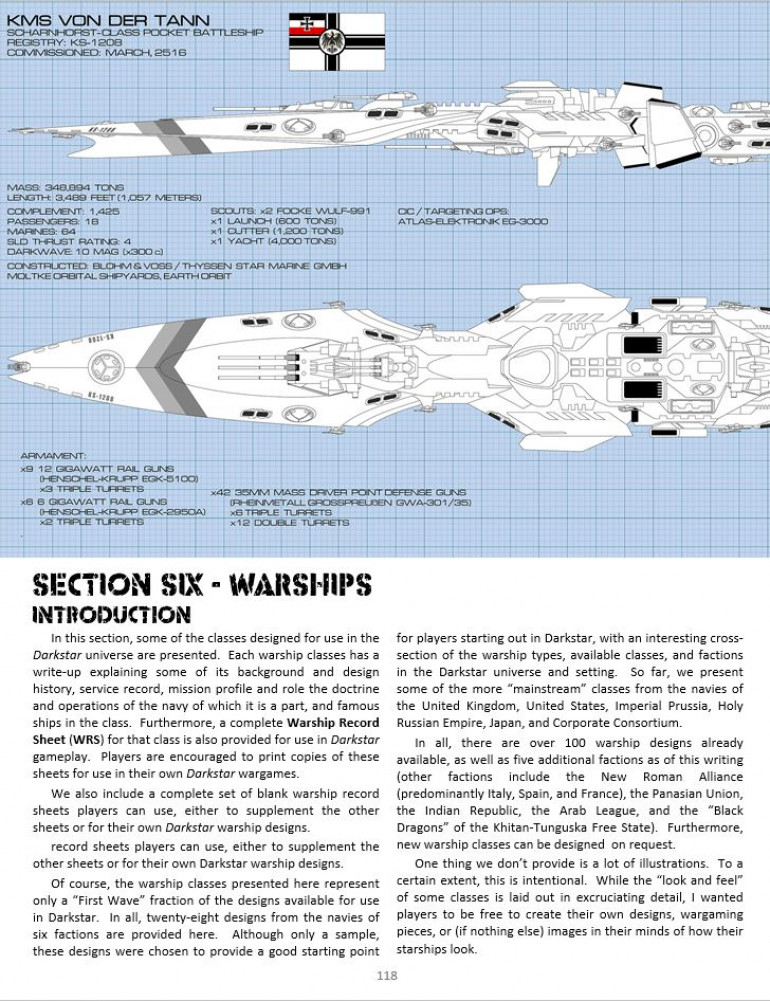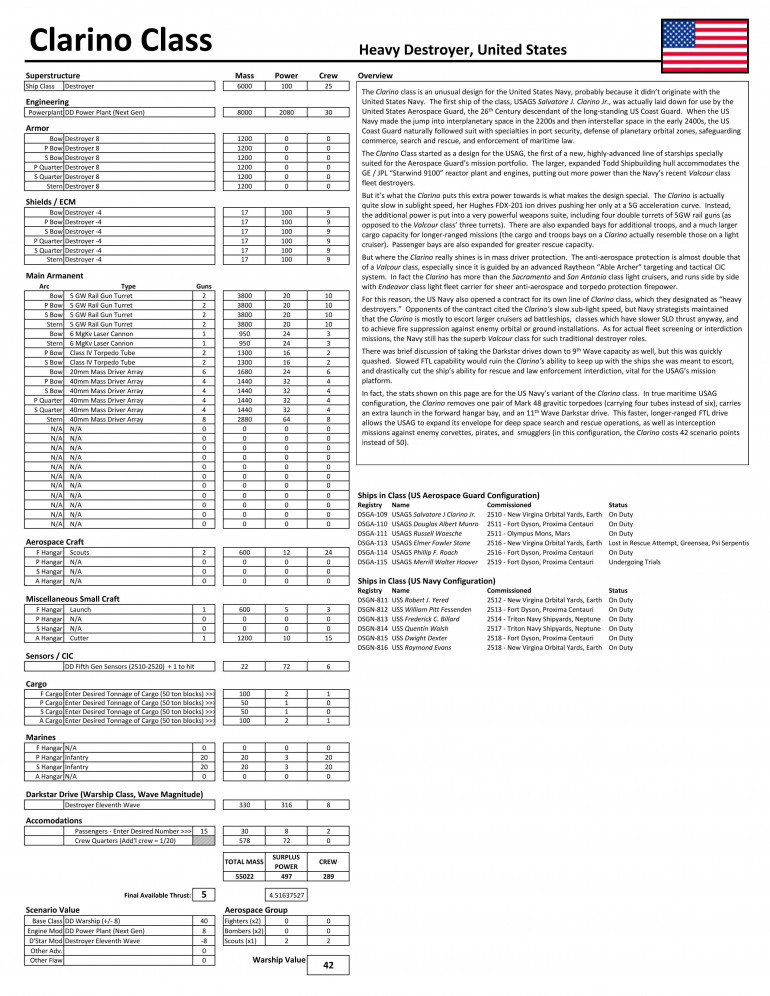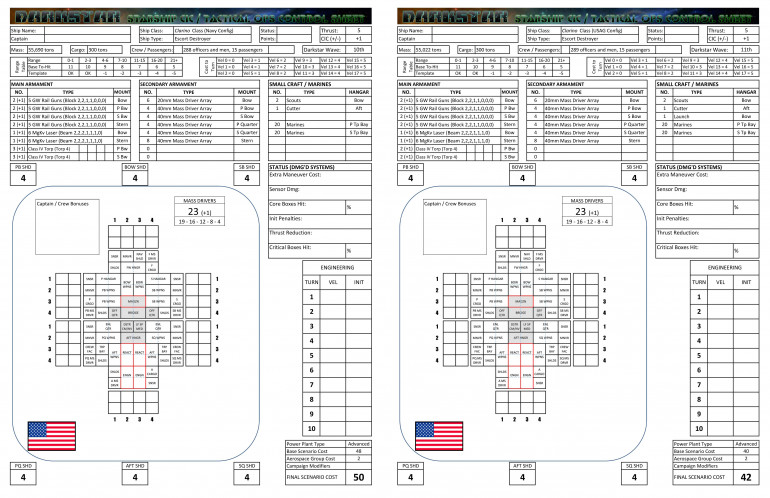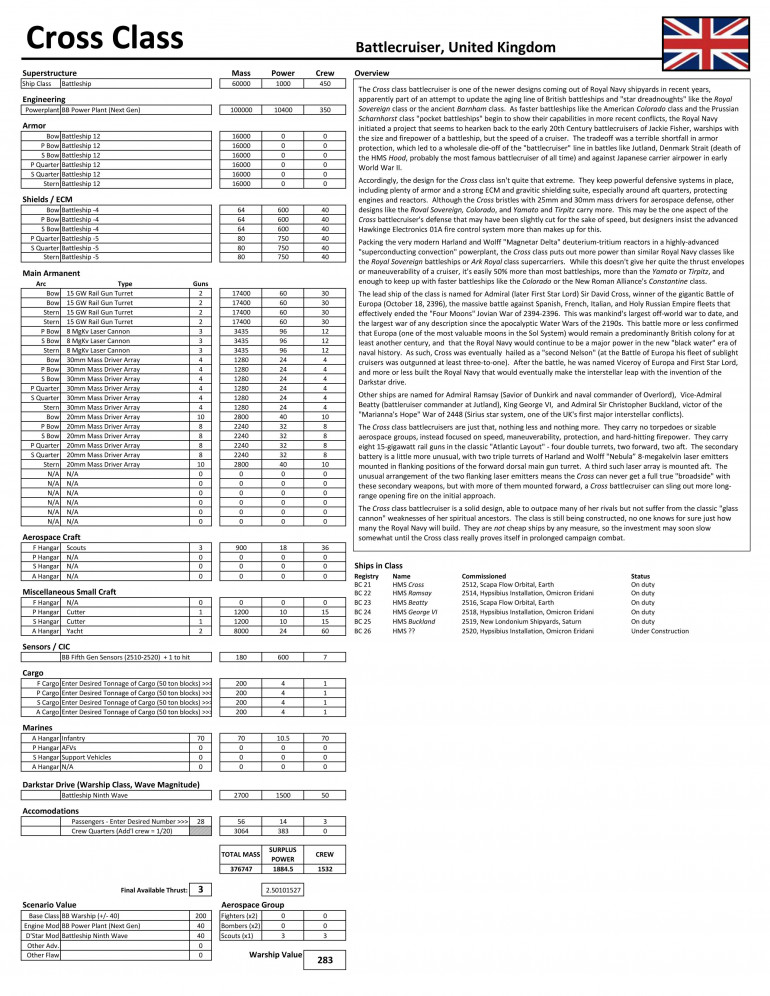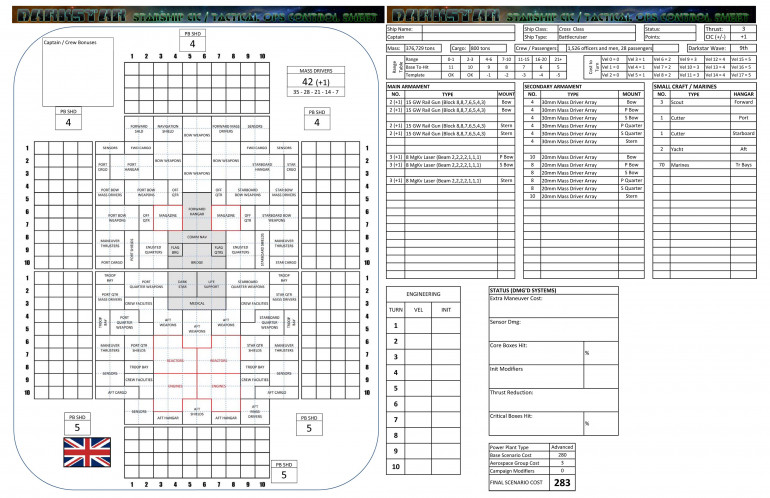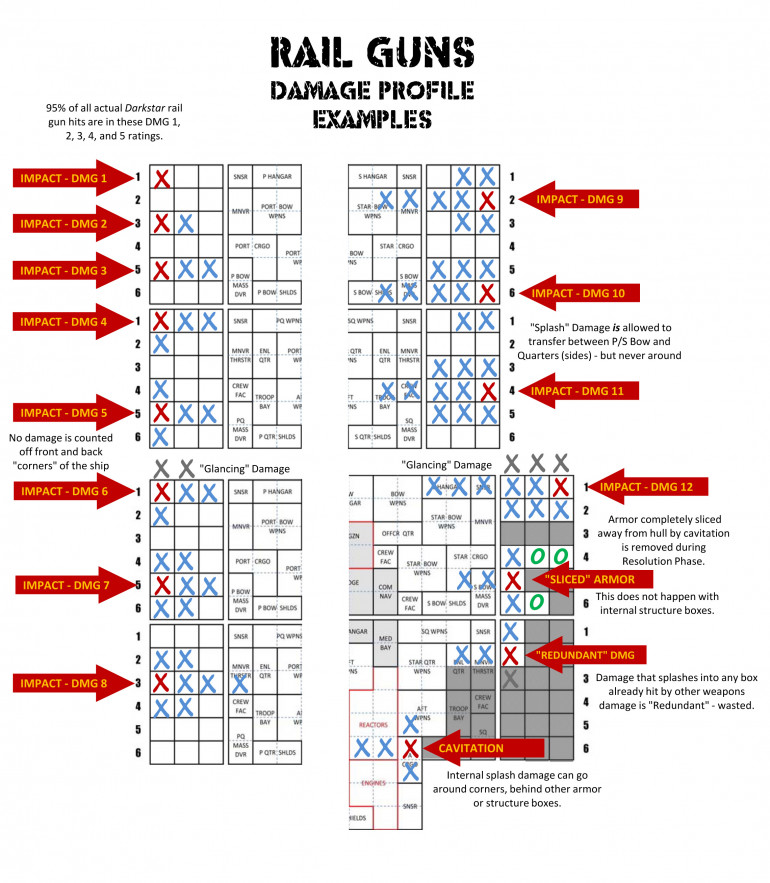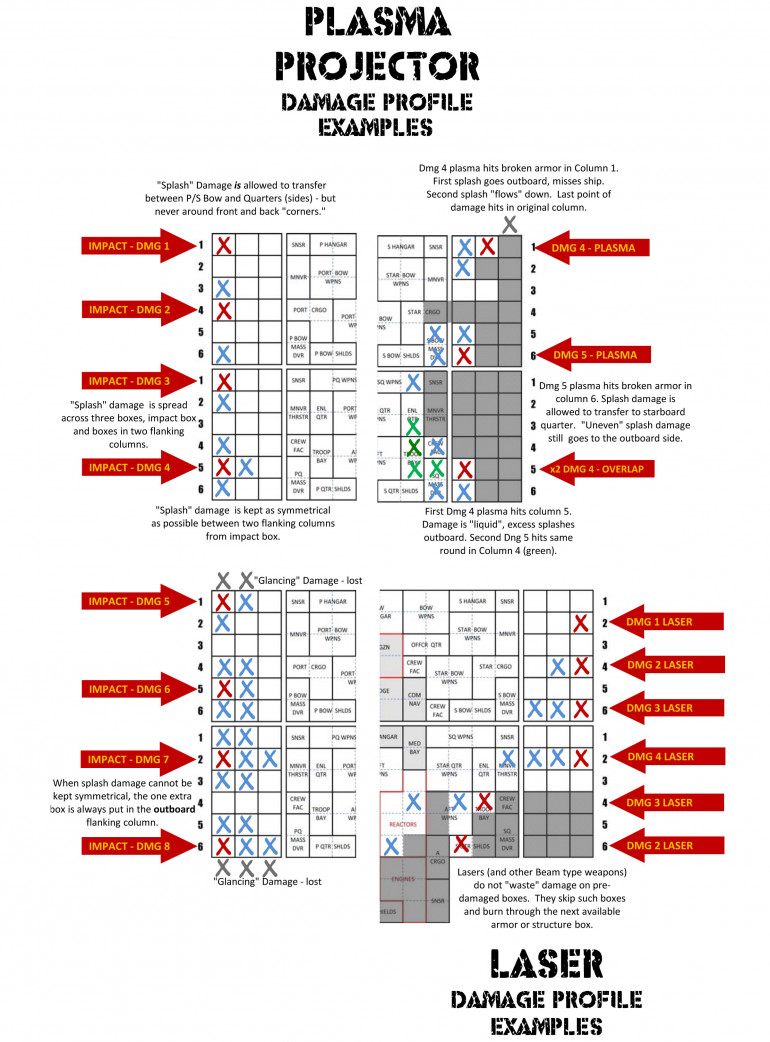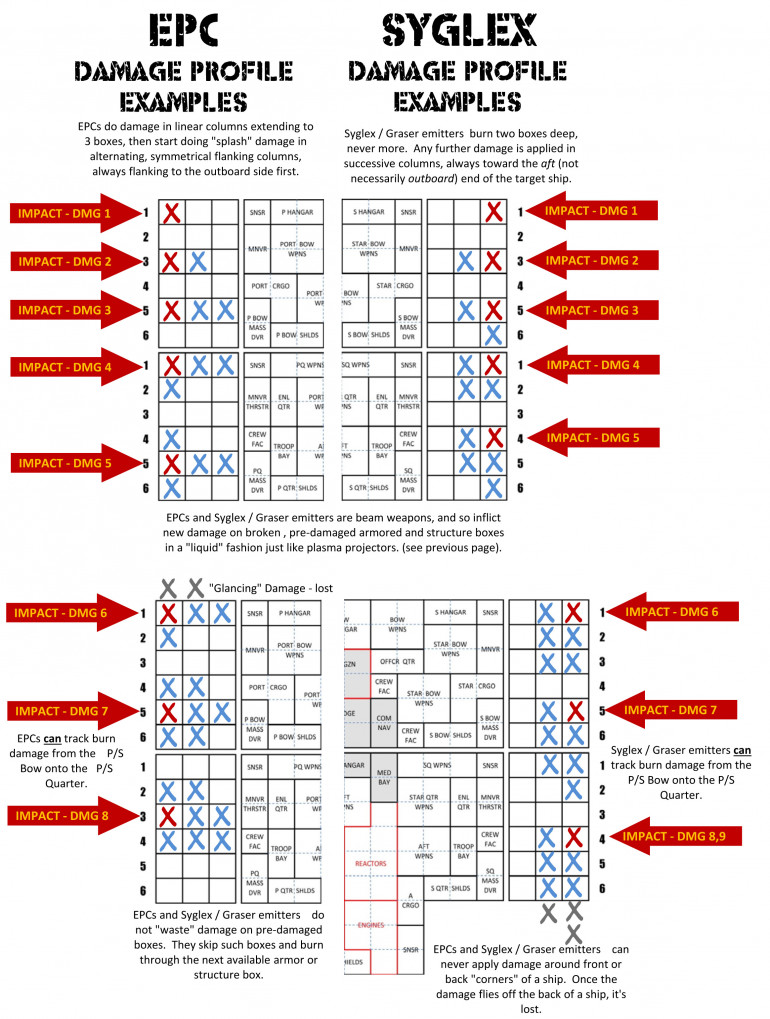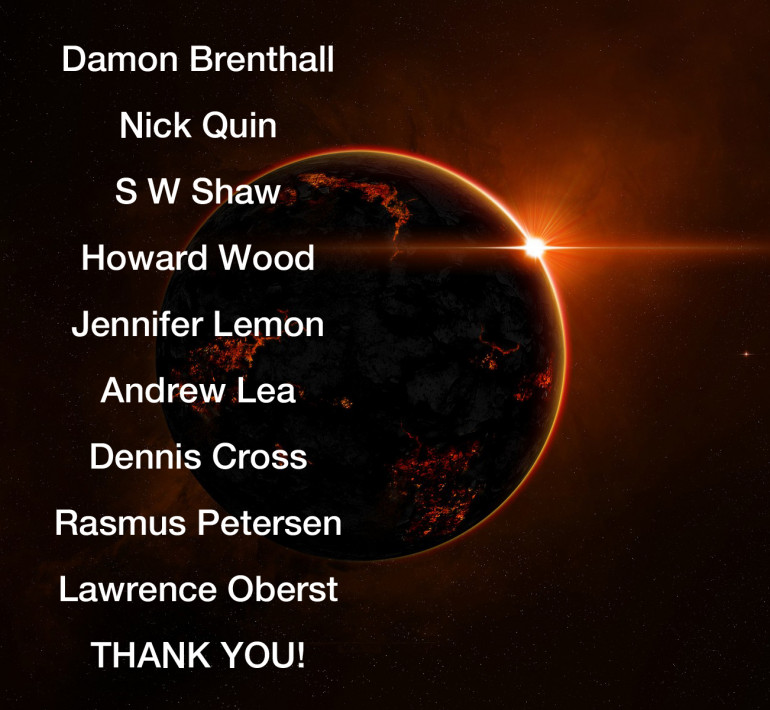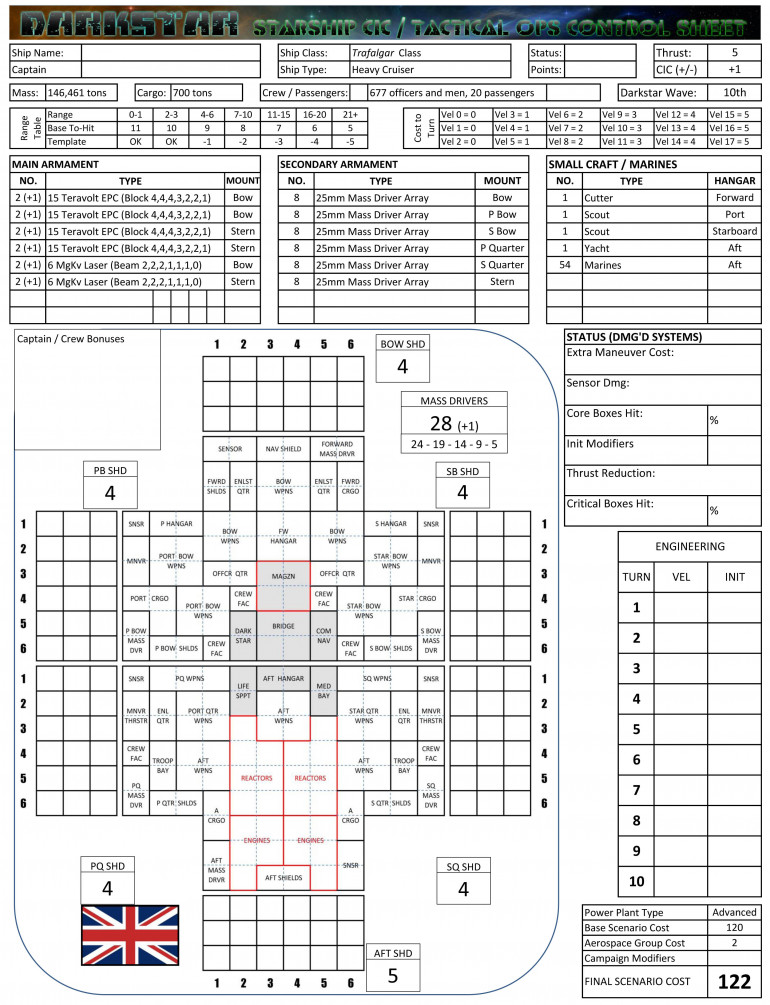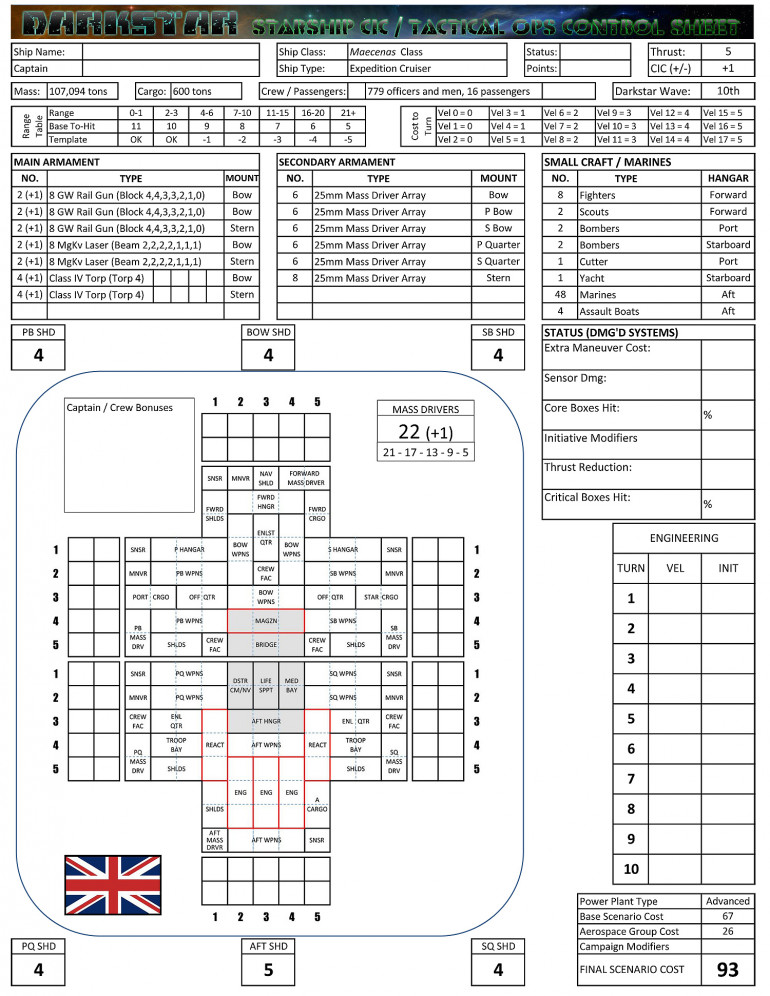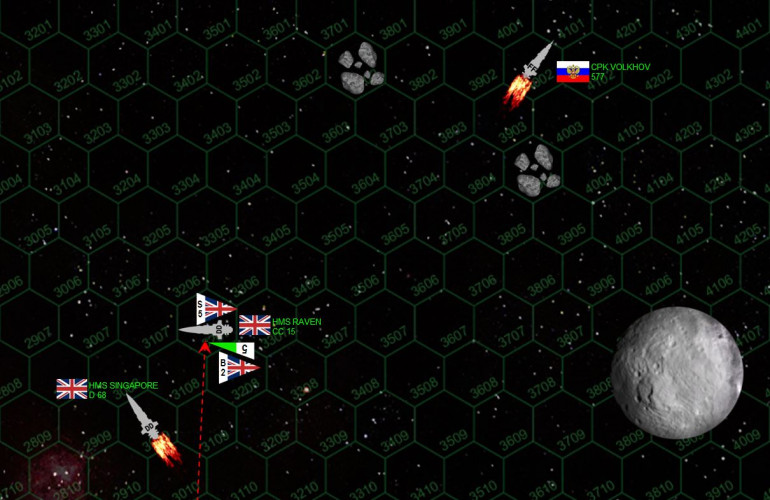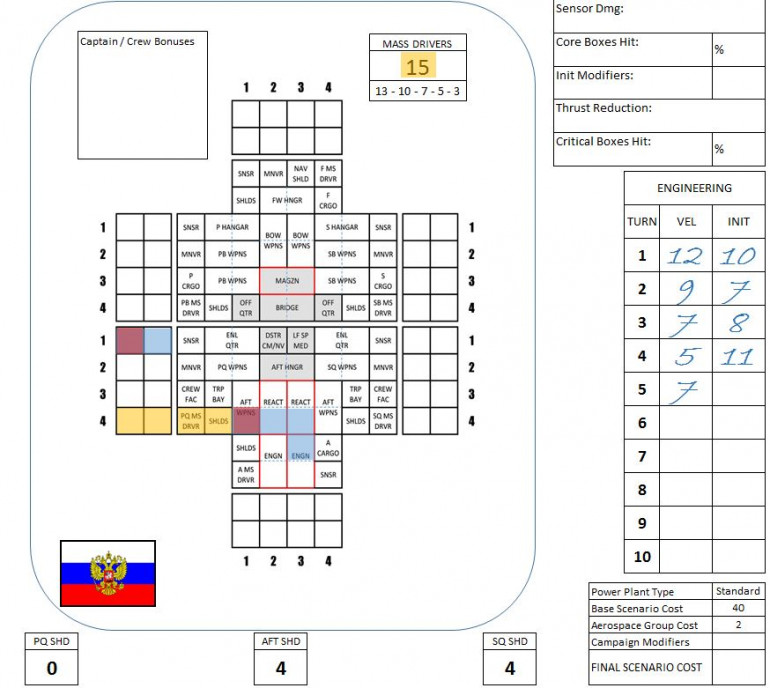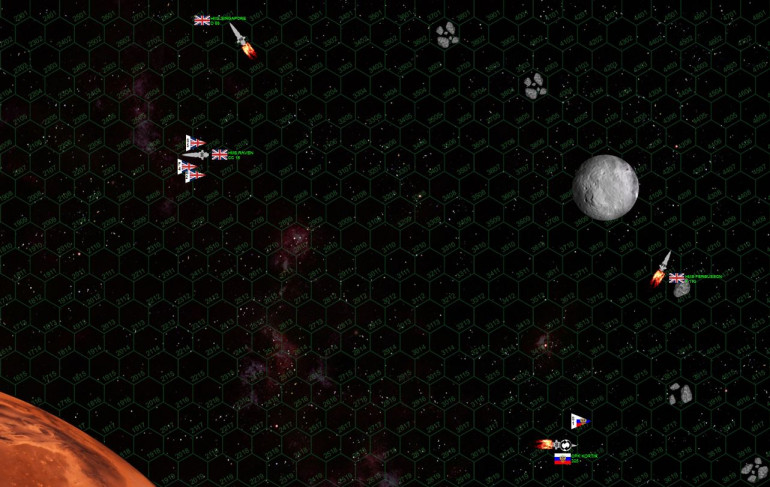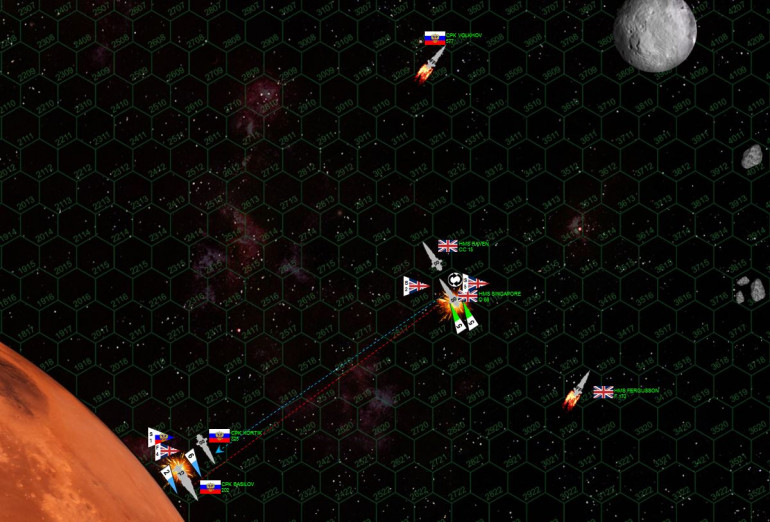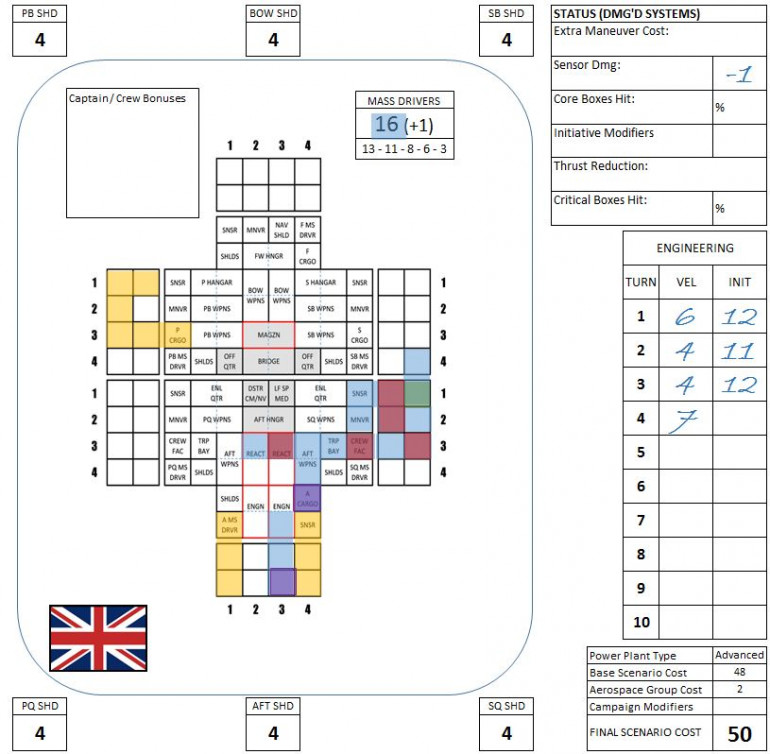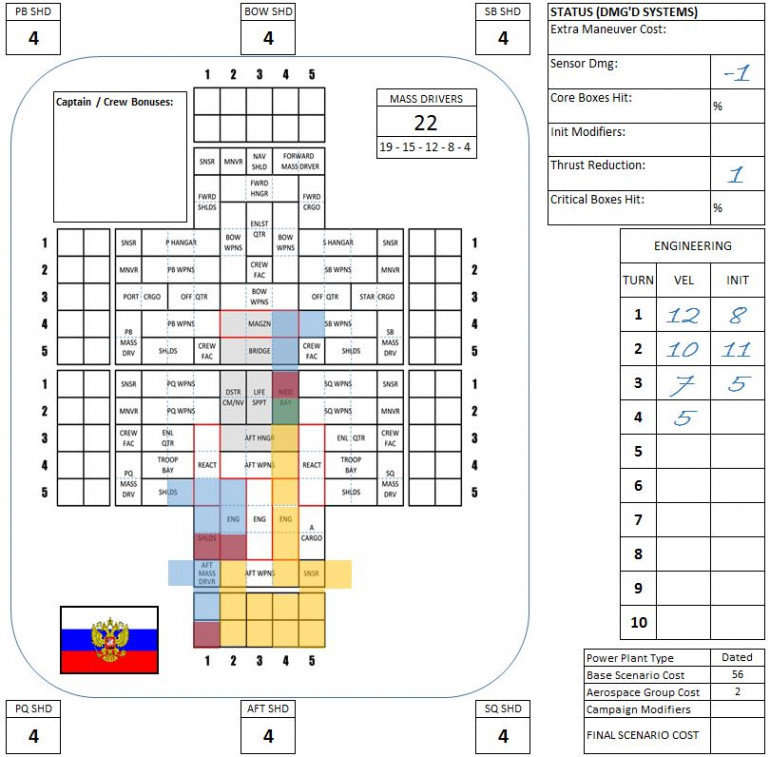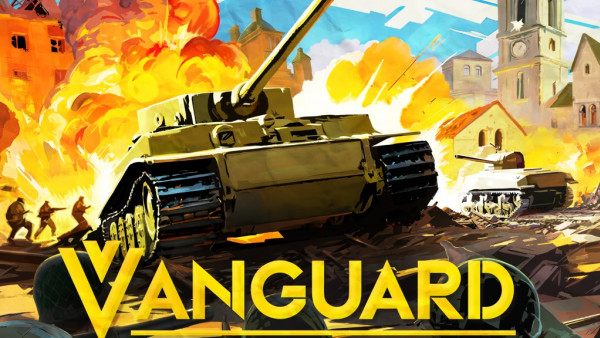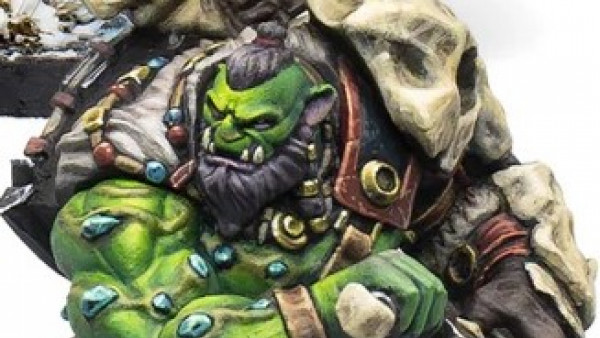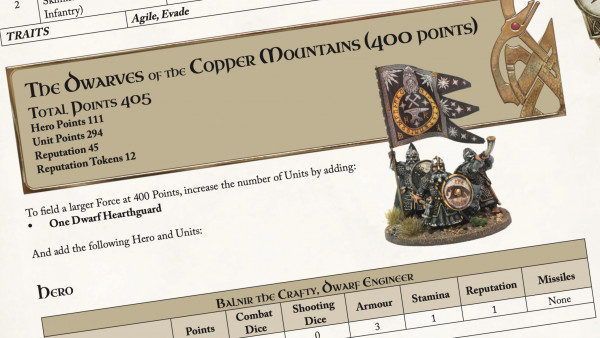
DARKSTAR CAMPAIGN UPDATE: DUCHESS ANNABEL’S WAR IS OVER
Recommendations: 3619
About the Project
The year is 2512.
The powers that remain on an ecologically-devastated and plague-ravaged Earth have been forced to look to the stars for the resources, capital, and room not only to expand, but to survive. While the setbacks encountered by mankind over the past 500 years have forced him to unite in a shaky global coalition and make fantastic strides in technology, they have also caused seismic and reactionary shifts in religion, culture, and politics. A second age of imperialism has dawned, and because man would never survive another war on the fragile remains of planet Earth, he is forced to ply his oldest trade ... war ... exclusively among the stars.
Darkstar is a tactical war game postulating naval combat in a “science faction” universe set five centuries into a troubled and uncertain future. Players take command of warships serving in the new “black water” navies of reborn empires of old, struggling for control of shipping lanes, resources, and colonies. Ships maneuver and fire in fast-paced combat, with survival not only of the players’ fleets at stake, but perhaps their nation and all of humanity as well.
Related Genre: Science Fiction
This Project is Active
British vs. Black Dragon Rebels
Okay, Darkstar fans, I’m happy to say we’ve had another great game this past weekend, where @damon from the community again took his new heavy cruiser HMS Bellapheron (Trafalgar Class) and escort destroyer HMS Essex (Falklands Class) into another battle, perhaps looking for a little redemption after the loss suffered at the hands of my Prussians last weekend (skirmish at Vancouver Station).
So Damon received this briefing from the first officer of Bellerophon’s first officer:
Good afternoon, sir. I have the honour of reporting that both HMS Bellerpheron and HMS Essex have completed shakedown cruises after their refits in Annabel’s Star dry dock.
- We also have orders from the Admiralty (Operations Office, Scorpio / Libra Strategic Command Sector, Commodore Sir David Pellard).
- We are to sortie at once, setting a Darkstar course back to the Gleise 682 (Harwood’s Hope, M3.5 red dwarf) star system, where we recently came up a little short against the Prussians at our orbital facilities at Vancouver Station.
- In the wake of that unfortunate scuffle, the Prussians have of course taken possession of Vancouver Station, and in fact used it to repair KMS Lutzow while we were laid up in drydock ourselves here at Annabel’s Star.
- In addition, the Prussians have also made themselves rather comfortable in the outer orbital zones, setting up automated detector buoys. Clearly they expect us to mount a push back into the system, and intend to be ready.
- Whether at Vancouver Station or in the outer orbital zones, Prussian naval presence in Gliese 682 is unacceptable. The Harwood’s Hope system is an important waypoint along our Empire’s shipping lanes from Annabel’s Star back toward our Core colonies and Earth. Prussian interference along this route cannot be allowed to stand.
- Furthermore, the Prussians’ allies, the Russian/Chinese rebels of the so-called Khitan-Tunguska Free State (the Black Dragons), have been allowed to stage some of their ships in Gliese 682.
- This has our Panasian allies in quite a state, as it puts the Black Dragons (their sworn enemies) just 8 light-years from Ross 154, their largest Core colony in the region.
- Accordingly, we are directed to probe the outer protoplanetary debris rings of Gleise 682, with a view to find and engage the reported Black Dragon battlegroup in the area. It is our hope that a solid enough defeat against these rebels might compel the Prussians to either weaken their defenses of Vancouver Station, pull in additional ships from other hard-pressed sectors throughout the warzone, or even abandon Harwood’s Hope altogether.
- Either way, a stiff blow against the Black Dragon rebels will placate our allies in the Panasian Union and Holy Russian Empire, perhaps enough to compel their help in expanded operations against the Prussian sector headquarters and shipyards at Eisenwolf Colony.
 So here’s the battle area, somewhere in the bottomless abyss of this star system’s outer protoplanetary debris fields (what we would call the “Kuiper Belt” in our home star system). The asteroids and planetismal you’re familiar with. Note the dust clouds. Any ship that has to fire INTO or THROUGH at least one dust cloud hex has to -1 from its target to hit number. Shooting through multiple dust cloud hexes is not cumulative.
So here’s the battle area, somewhere in the bottomless abyss of this star system’s outer protoplanetary debris fields (what we would call the “Kuiper Belt” in our home star system). The asteroids and planetismal you’re familiar with. Note the dust clouds. Any ship that has to fire INTO or THROUGH at least one dust cloud hex has to -1 from its target to hit number. Shooting through multiple dust cloud hexes is not cumulative. 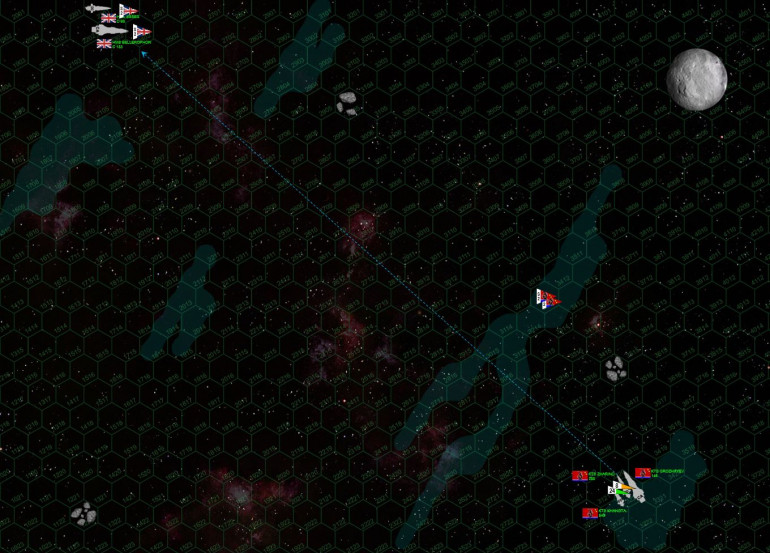 So here’s the set up. Damon has the HMS Bellepheron (nicknamed “Billy Ruffian” as her namesake was at the Battle of Trafalgar – 1805) and escort ship, the Falklands class destroyer HMS Essex. That’s 122 + 50 = 172 points. The Black Dragons have the Russian-built Slava class heavy cruiser KTS Grozhayev (102 points), the Russian-built Sovnya class destroyer KTS Zharino (42 points), and the Panasian built Zhao Ha class missile frigate Khangta (21 points). This puts the Black Dragons 7 points short, so I install the “ECM/Shielding” upgrade on the Zharino (20% of the destroyer’s base cost = 8), to bring their available forces to 173. Then, the Khangta’s scout plane goes on the fritz, and is down for maintenance for this battle, bringing the game to a perfect 172 point balance. Both battlegroups enter the board and opening volleys are exchanged at the absurd distance of 28 hexes = just over 5000 kilometers, the distance between Coleraine and Tehran.
So here’s the set up. Damon has the HMS Bellepheron (nicknamed “Billy Ruffian” as her namesake was at the Battle of Trafalgar – 1805) and escort ship, the Falklands class destroyer HMS Essex. That’s 122 + 50 = 172 points. The Black Dragons have the Russian-built Slava class heavy cruiser KTS Grozhayev (102 points), the Russian-built Sovnya class destroyer KTS Zharino (42 points), and the Panasian built Zhao Ha class missile frigate Khangta (21 points). This puts the Black Dragons 7 points short, so I install the “ECM/Shielding” upgrade on the Zharino (20% of the destroyer’s base cost = 8), to bring their available forces to 173. Then, the Khangta’s scout plane goes on the fritz, and is down for maintenance for this battle, bringing the game to a perfect 172 point balance. Both battlegroups enter the board and opening volleys are exchanged at the absurd distance of 28 hexes = just over 5000 kilometers, the distance between Coleraine and Tehran. 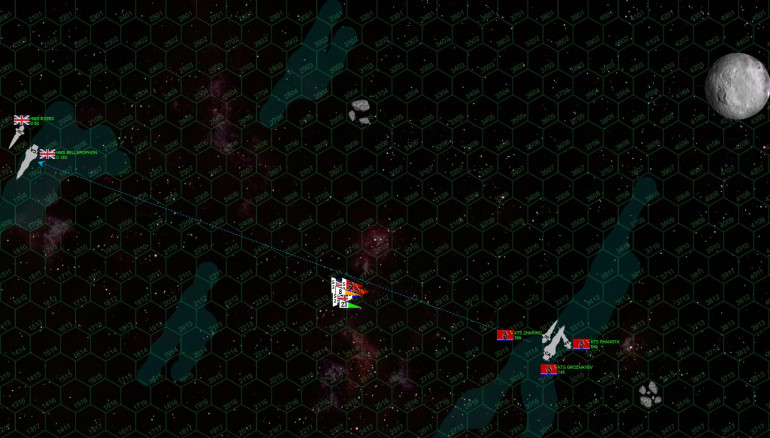 Damon keeps sidestepping with his two British ships, clearly hoping to outdistance (or at least delay the impact) of my torpedoes, while whittling them down with his scouts. My scouts keep trying to shoot down his, but to no success. Meanwhile, we’re slapping at each other still over very long gunnery distances, where Damon’s ships will have something of an advantage as his guns are more accurate. I’m still trying to close the range, of course, where my larger Russian and Chinese guns (especially the dreaded Russian plasma projectors) will have greater impact.
Damon keeps sidestepping with his two British ships, clearly hoping to outdistance (or at least delay the impact) of my torpedoes, while whittling them down with his scouts. My scouts keep trying to shoot down his, but to no success. Meanwhile, we’re slapping at each other still over very long gunnery distances, where Damon’s ships will have something of an advantage as his guns are more accurate. I’m still trying to close the range, of course, where my larger Russian and Chinese guns (especially the dreaded Russian plasma projectors) will have greater impact. 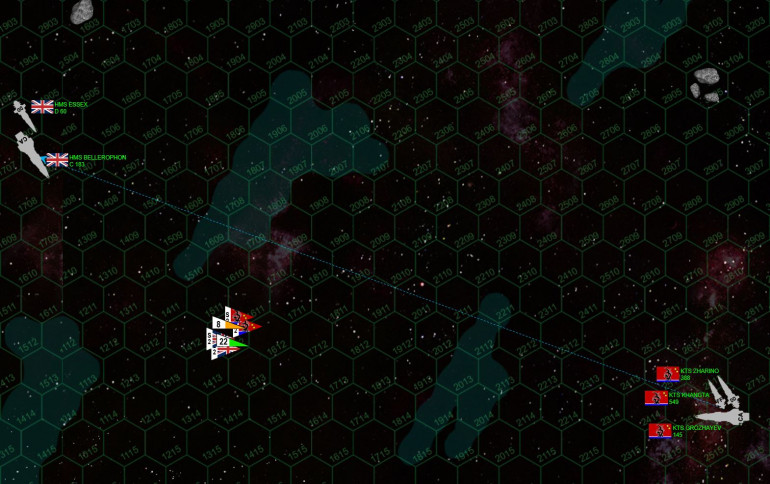 Damon keeps playing hard to get. The range is now “down” to 20 hexes, 3600 kilometers. All this time, Damon’s been trying to hit the smallest ship in my fleet, the frigate Khangta. This is to maybe score an “easy” early kill, knocking down my firepower a little before the two sides really come to grips, and reducing the number of torpedoes I can throw at him in one turn. Besides, as Damon learned to his cost last week, once these ships get close, there’s practically no way a heavy cruiser can get frigates or corvettes off her stern.
Damon keeps playing hard to get. The range is now “down” to 20 hexes, 3600 kilometers. All this time, Damon’s been trying to hit the smallest ship in my fleet, the frigate Khangta. This is to maybe score an “easy” early kill, knocking down my firepower a little before the two sides really come to grips, and reducing the number of torpedoes I can throw at him in one turn. Besides, as Damon learned to his cost last week, once these ships get close, there’s practically no way a heavy cruiser can get frigates or corvettes off her stern. 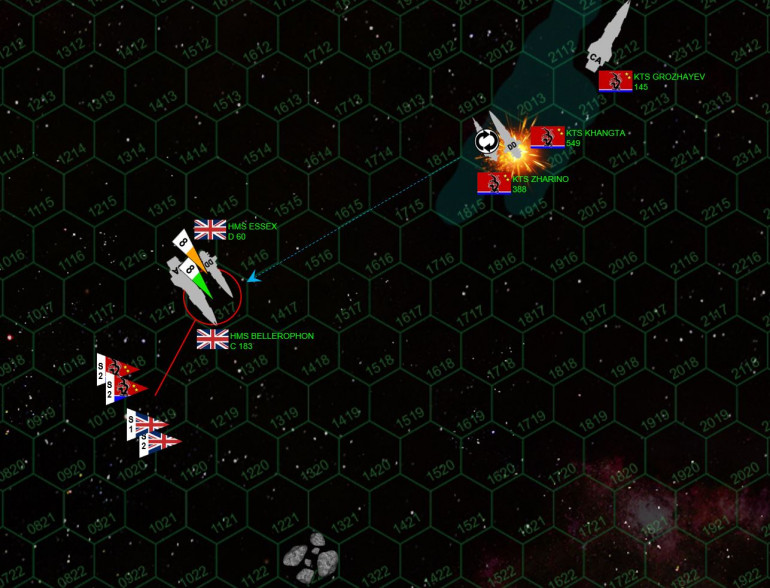 Things finally get serious on Turn 4. The Grozhayev blows an initiative roll, and I try to turn to starboard in an attempt to present a possible broadside at the British. This allows Damon to accelerate (the Trafalgar class is actually pretty fast for a heavy cruiser) and turn to port, cutting a broadside across Grozhayev’s stern. I hope to either (a) mitigate the damage by responding with closer broadsides of my frigate and destroyer, or (b) offer up the smaller ships as bait to save my heavy cruiser. Damon “takes the bait,” and but both his ships into a punishing broadside into the Khangta and Zharino. The Khangta (being a frigate) is much more fragile and takes more damage, but believe it or not - it’s the Zharino that loses power and is now burning and adrift in space.
Things finally get serious on Turn 4. The Grozhayev blows an initiative roll, and I try to turn to starboard in an attempt to present a possible broadside at the British. This allows Damon to accelerate (the Trafalgar class is actually pretty fast for a heavy cruiser) and turn to port, cutting a broadside across Grozhayev’s stern. I hope to either (a) mitigate the damage by responding with closer broadsides of my frigate and destroyer, or (b) offer up the smaller ships as bait to save my heavy cruiser. Damon “takes the bait,” and but both his ships into a punishing broadside into the Khangta and Zharino. The Khangta (being a frigate) is much more fragile and takes more damage, but believe it or not - it’s the Zharino that loses power and is now burning and adrift in space. 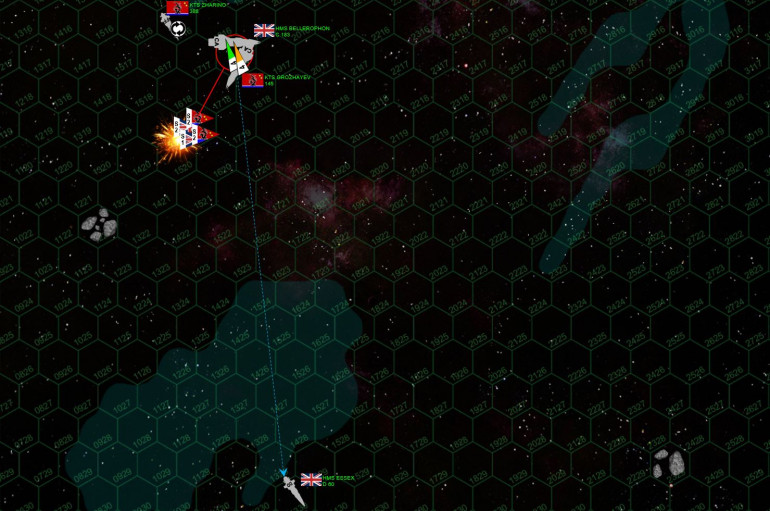 Again the Grozhayev loses initiative. This isn’t just bad dice, the Billy Ruffian has a better chance here due to her higher thrust (surplus power / mass ratio). Anyway, I cut toward the Bellopheron, hoping to avoid another broadside across my stern, or at the very least, close the range where my big Russian flamethrowers will burn the Billy Ruffian into the “Beefsteak Ruffian.” Well, I get one of my wishes. We are now in the same hex (less than 100 kilometers apart). Now I can only fire my aft guns, and Damon can fire ALL of his guns. Also, he’s shooting into my stern, I’m shooting into his starboard bow. So does the Khangta. The Essex wasn’t no part of this apocalyptic shooting match, and can’t turn away in time, so instead has to power FORWARD in the hopes that distance and dust clouds will keep her safe from Grozhayev;s forward guns (you know, the ones that CAN’T shoot at Beefsteak Ruffian).
Again the Grozhayev loses initiative. This isn’t just bad dice, the Billy Ruffian has a better chance here due to her higher thrust (surplus power / mass ratio). Anyway, I cut toward the Bellopheron, hoping to avoid another broadside across my stern, or at the very least, close the range where my big Russian flamethrowers will burn the Billy Ruffian into the “Beefsteak Ruffian.” Well, I get one of my wishes. We are now in the same hex (less than 100 kilometers apart). Now I can only fire my aft guns, and Damon can fire ALL of his guns. Also, he’s shooting into my stern, I’m shooting into his starboard bow. So does the Khangta. The Essex wasn’t no part of this apocalyptic shooting match, and can’t turn away in time, so instead has to power FORWARD in the hopes that distance and dust clouds will keep her safe from Grozhayev;s forward guns (you know, the ones that CAN’T shoot at Beefsteak Ruffian). 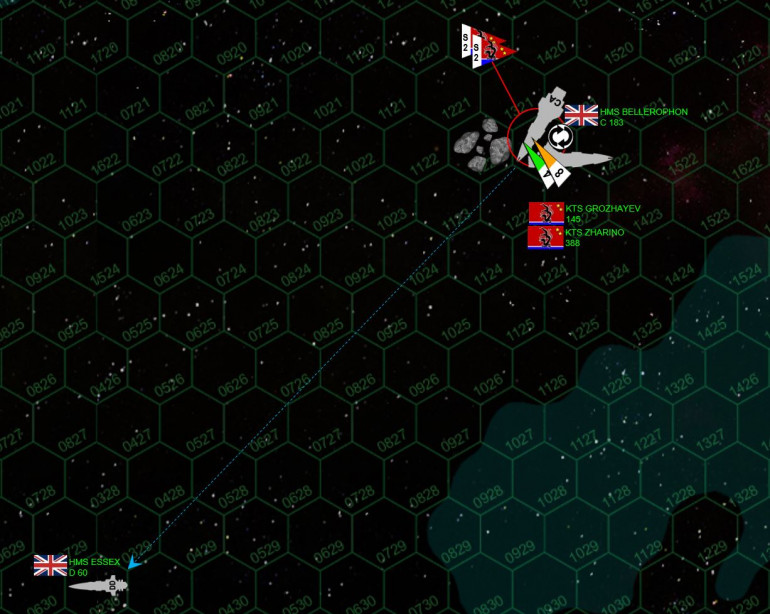 Well, believe it or not we both survived that, although Grozhayev is realty in trouble here. AGAIN I lose initiative, so instead I now cut with my stern to an asteroid in the hopes of covering my damaged fantail. Nope, not if the Bellopheron feels lucky enough to survive ANOTHER point-blank plasma projector barbeque! “I like my British . . . extra crispy!”
Well, believe it or not we both survived that, although Grozhayev is realty in trouble here. AGAIN I lose initiative, so instead I now cut with my stern to an asteroid in the hopes of covering my damaged fantail. Nope, not if the Bellopheron feels lucky enough to survive ANOTHER point-blank plasma projector barbeque! “I like my British . . . extra crispy!”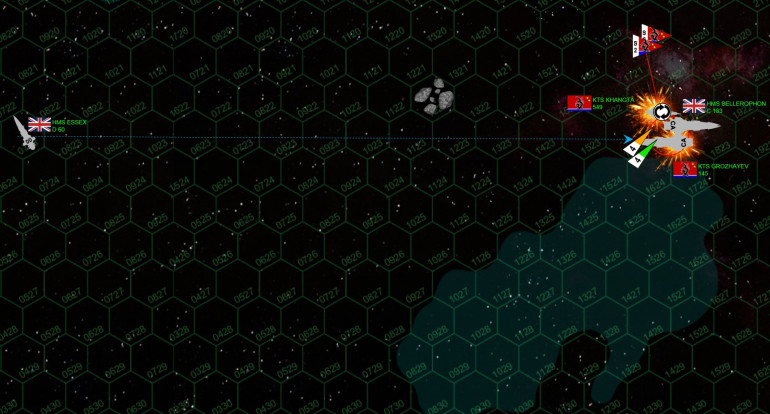 Trying my damnedest to shake the Broiled Ruffian off my ass, I accelerate the Grozhayev three more KPS and then have just enough thrust to pull a fishhook 180-degree turn, hoping to keep my stern out to deep space. Now finally this is a move the Bellopheron cannot match (she’s lost maneuvering thrusters and three sensors by this point. But I have NO AFT SHIELDS, one more volley on the stern and I’ve had it. The only way Bellopheron can do this is to scream straight at me, then, as she’s passing AGAIN in the same hex, put her aft guns into my stern. This finally does it, not QUITE doing enough damage to the Grozhayev to explode her reactors (for the Bruised Ruffian, that would be VERY bad at this point). Meanwhile, the Essex, which has been more or less circling the cruisers, pinging in with long-ranged fire while trying to slow down and not fly off the map, scores a broadside into the reeling wreck of the little Khangta, finally crippling here as well.
Trying my damnedest to shake the Broiled Ruffian off my ass, I accelerate the Grozhayev three more KPS and then have just enough thrust to pull a fishhook 180-degree turn, hoping to keep my stern out to deep space. Now finally this is a move the Bellopheron cannot match (she’s lost maneuvering thrusters and three sensors by this point. But I have NO AFT SHIELDS, one more volley on the stern and I’ve had it. The only way Bellopheron can do this is to scream straight at me, then, as she’s passing AGAIN in the same hex, put her aft guns into my stern. This finally does it, not QUITE doing enough damage to the Grozhayev to explode her reactors (for the Bruised Ruffian, that would be VERY bad at this point). Meanwhile, the Essex, which has been more or less circling the cruisers, pinging in with long-ranged fire while trying to slow down and not fly off the map, scores a broadside into the reeling wreck of the little Khangta, finally crippling here as well.  What a British victory. Both the Bellopheron and Essex are still operational (although VERY worse for wear), while the whole Black Dragon task force has been crippled. All three Black Dragon ships will make their recovery checks, however, perhaps proof of just how serious the Prussians are about keeping them as allies. This will mean the Prussians are evacuating the Harwood’s Hope system, however (last week’s minor British defeat vs today’s major British victory = a net British minor victory), so the Prussians will but their losses and help their allies limp back to Eisenwolf Colony. Meanwhile, here is the WRS of the “Battered Ruffian.” It’s a good thing the Grozhayev finally went dark when she did, Damon’s flagship looks like she needs another refit in dry dock! Indeed, what the Trafalgar class’ design “spends” in speed and technology, the Slava class spends in armor and shielding. Like most Russian ships, she’s more than a little sturdy.
What a British victory. Both the Bellopheron and Essex are still operational (although VERY worse for wear), while the whole Black Dragon task force has been crippled. All three Black Dragon ships will make their recovery checks, however, perhaps proof of just how serious the Prussians are about keeping them as allies. This will mean the Prussians are evacuating the Harwood’s Hope system, however (last week’s minor British defeat vs today’s major British victory = a net British minor victory), so the Prussians will but their losses and help their allies limp back to Eisenwolf Colony. Meanwhile, here is the WRS of the “Battered Ruffian.” It’s a good thing the Grozhayev finally went dark when she did, Damon’s flagship looks like she needs another refit in dry dock! Indeed, what the Trafalgar class’ design “spends” in speed and technology, the Slava class spends in armor and shielding. Like most Russian ships, she’s more than a little sturdy. 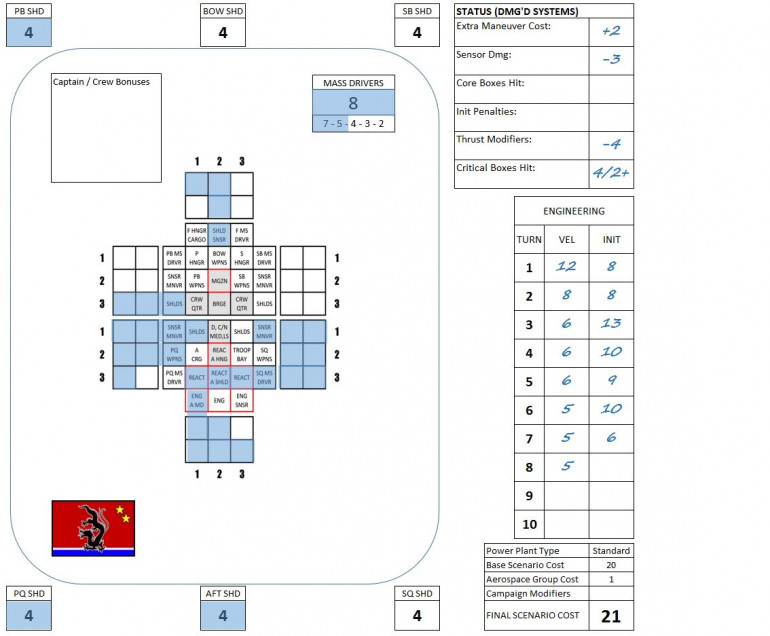 Meanwhile, the Khangta. I can’t believe this ship made her Warship Recovery Check, it has been a while since I’ve seen a frigate take this much damage and actually survive. Indeed, that battle went through Turn 7, pretty unusual for a Darkstar game. This was definitely a nasty one, where both sides were playing for keeps and no one’s ships wanted to give up the fight. Congrats to Damon on a well-fought victory!
Meanwhile, the Khangta. I can’t believe this ship made her Warship Recovery Check, it has been a while since I’ve seen a frigate take this much damage and actually survive. Indeed, that battle went through Turn 7, pretty unusual for a Darkstar game. This was definitely a nasty one, where both sides were playing for keeps and no one’s ships wanted to give up the fight. Congrats to Damon on a well-fought victory! Task Force Oriskany vs. Black Dragons (P2)
The conclusion of the battle between Task Force Oriskany and the Black Dragons of Task Force Tzarakin.
So far, the Americans are doing well. Yes, this game is balanced in points (365-366) but honestly I’ve played some of these ships upwards of 100 times, so I know them very well. This is @gladesrunner’s first time playing with these classes. So I admittedly do have an “unofficial” edge.
I put that edge to good use, angling my approach partially behind a planet to screen myself from some of what should have been a devastating initial Black Dragon volley.
Then I jack-knife turned away from her, outpacing her slower Panasian torpedoes, fatally breaking her ordinance strike into two waves (aerospace wave I have already largely defeated, and an incoming capital warship torpedo wave in Turn 3).
The heaviest Black Dragon warship, the Russian-built Slava class heavy cruiser Tzarakin is already down, almost exploded, in fact … so hopefully the Americans can now lean on this early lead and eventually win the game.
But now the Oriskany’s rival ship, the hated Xhia class light missile cruiser Zhang Jia, leads the rest of the Black Dragons to closer gunnery range (where my advantages in accuracy and tech and speed mean much less), and of course that massive Black Dragon torpedo wave is finally about to hit …
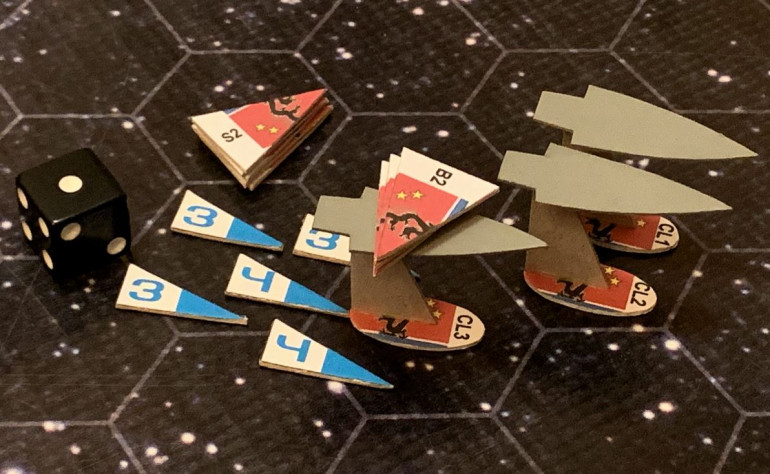 As the Black Dragon torpedoes are coming in against USS Oriskany, Princeton, and Daggerfish, American Mark 48 torpedoes are coming in against the Black Dragons. Last turn, however, I was unable to launch anything close to a full spread because that jack-knife turn had many of my tubes pointing the wrong way. The end result is that the Black Dragons, especially the Zhang Jia with her electronic warfare battle upgrade, have more than enough mass driver fire to destroy my torpedoes before they hit anything.
As the Black Dragon torpedoes are coming in against USS Oriskany, Princeton, and Daggerfish, American Mark 48 torpedoes are coming in against the Black Dragons. Last turn, however, I was unable to launch anything close to a full spread because that jack-knife turn had many of my tubes pointing the wrong way. The end result is that the Black Dragons, especially the Zhang Jia with her electronic warfare battle upgrade, have more than enough mass driver fire to destroy my torpedoes before they hit anything.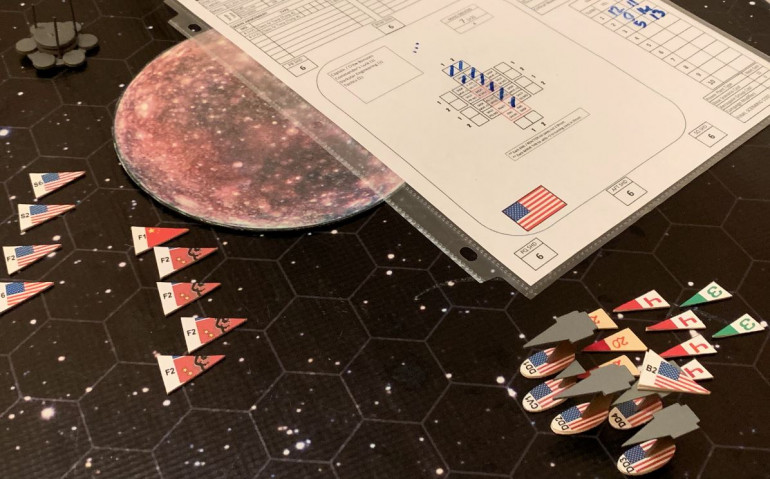 Black Dragon torpedoes have also been largely suppressed, although a few "Tsing Tao" Class II Panasian torpedoes have struck the fantail of the USS Princeton, Engines are hit and Jenn will have a chance to roll to see if she's crippled during the Resolution Phase. Meanwhile, the little USS Daggerfish has been hit by Black Dragon guns, not easy given the Daggerfish's tiny size and advance ECM / gravitic shielding. Nevertheless, she's taken more than enough damage to leave her crippled and adrift in space. The first American ship is down! It might seem strange to pick on such a small ship this early in the game, but in fact knocking out enemy torpedo corvettes is usually not a bad idea early in the battle. They don't take too many hits to destroy, and knocking them out means far less torpedoes harassing you every turn. Meanwhile, the Marines of fighter/strike squadron VMF/A-319 (“Tigersharks”) are winning the fighter battle near the moon.
Black Dragon torpedoes have also been largely suppressed, although a few "Tsing Tao" Class II Panasian torpedoes have struck the fantail of the USS Princeton, Engines are hit and Jenn will have a chance to roll to see if she's crippled during the Resolution Phase. Meanwhile, the little USS Daggerfish has been hit by Black Dragon guns, not easy given the Daggerfish's tiny size and advance ECM / gravitic shielding. Nevertheless, she's taken more than enough damage to leave her crippled and adrift in space. The first American ship is down! It might seem strange to pick on such a small ship this early in the game, but in fact knocking out enemy torpedo corvettes is usually not a bad idea early in the battle. They don't take too many hits to destroy, and knocking them out means far less torpedoes harassing you every turn. Meanwhile, the Marines of fighter/strike squadron VMF/A-319 (“Tigersharks”) are winning the fighter battle near the moon.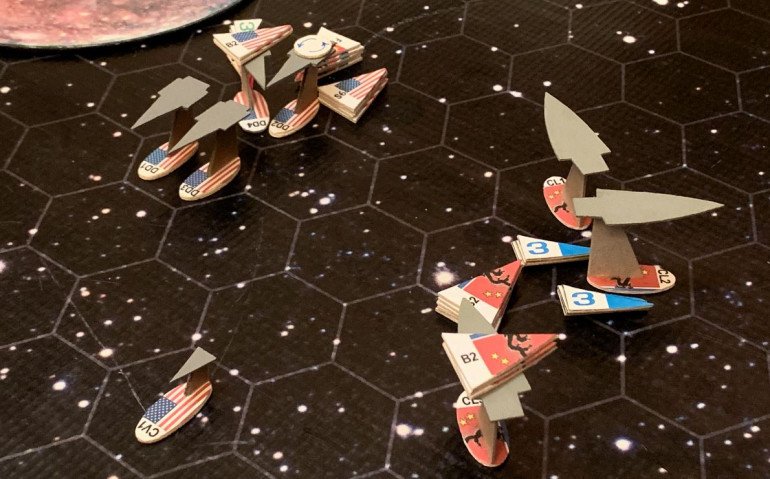 End of movement on Turn 4. Because our ships are smaller, faster, and ALL have the "Starship Tactics" battle upgrade (+20% scenario cost), the Americans will almost always win initiative. This means the Black Dragons have to guess where they will be when taking their movement. This is starting to disorganize the Black dragon fleet a little, as Jenn tries to have guns pointing where she thinks the Americans might be. Also, I'm leaning on Darkstar table experience a little more here as well. Note how my ships are closer to the moon, stern toward the moon. This means that in order to turn toward me, Jenn has to aim her ships toward the moon, desperately dangerous since any ship that loses power on such a trajectory is gone forever. Things aren't all great for the Americans, the corvette Daggerfish (CV1) is now careening out of the battle area, on fire and out of control. And as the bombers of VMF/A-319 try to re-arm aboard the Marine assault carrier USS Tarawa, the Tarawa is about to be hit by still more Black Dragon torpedoes.
End of movement on Turn 4. Because our ships are smaller, faster, and ALL have the "Starship Tactics" battle upgrade (+20% scenario cost), the Americans will almost always win initiative. This means the Black Dragons have to guess where they will be when taking their movement. This is starting to disorganize the Black dragon fleet a little, as Jenn tries to have guns pointing where she thinks the Americans might be. Also, I'm leaning on Darkstar table experience a little more here as well. Note how my ships are closer to the moon, stern toward the moon. This means that in order to turn toward me, Jenn has to aim her ships toward the moon, desperately dangerous since any ship that loses power on such a trajectory is gone forever. Things aren't all great for the Americans, the corvette Daggerfish (CV1) is now careening out of the battle area, on fire and out of control. And as the bombers of VMF/A-319 try to re-arm aboard the Marine assault carrier USS Tarawa, the Tarawa is about to be hit by still more Black Dragon torpedoes. 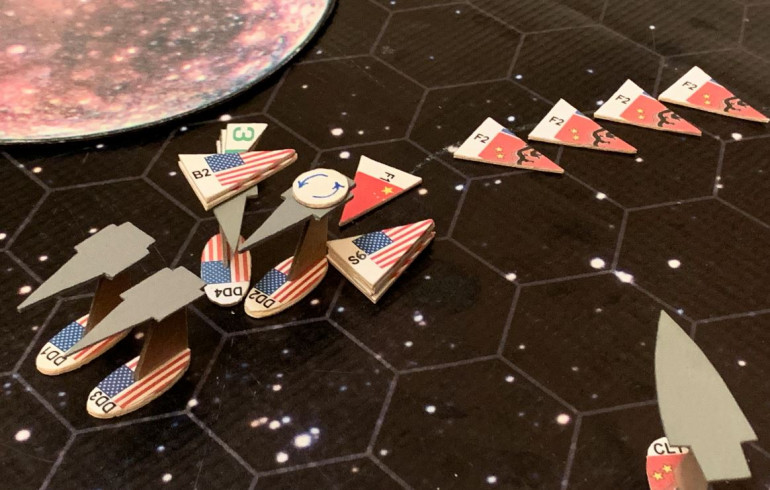 Death of the Black Dragon fighter wing. They try to swing in to help shoot up the Tarawa's tail, but the Marines scouts and fighters of the "Tigershark" squadron have issue with the assault on their mother ship. The Black dragon fighters are massacred, only one survives from the entire Zharanyeva fighter group. But ... those torpedoes do the job after all (beneath the green "3" behind American DD4)! Enough of them hit Tarawa's fantail to wreck her engines and reactors. She will fail her cripple check during Resolution Phase, and the Tarawa is knocked out of the battle! Worse still, those four bombers were still in her hangar bays, so they are considered "destroyed units" as well. And while I've been bragging about how awesome these Marine pilots and aerospace craft are, the flip side is that this makes them very expensive. So I've just lost a lot of scenario points here. Good shooting Jenn!
Death of the Black Dragon fighter wing. They try to swing in to help shoot up the Tarawa's tail, but the Marines scouts and fighters of the "Tigershark" squadron have issue with the assault on their mother ship. The Black dragon fighters are massacred, only one survives from the entire Zharanyeva fighter group. But ... those torpedoes do the job after all (beneath the green "3" behind American DD4)! Enough of them hit Tarawa's fantail to wreck her engines and reactors. She will fail her cripple check during Resolution Phase, and the Tarawa is knocked out of the battle! Worse still, those four bombers were still in her hangar bays, so they are considered "destroyed units" as well. And while I've been bragging about how awesome these Marine pilots and aerospace craft are, the flip side is that this makes them very expensive. So I've just lost a lot of scenario points here. Good shooting Jenn! 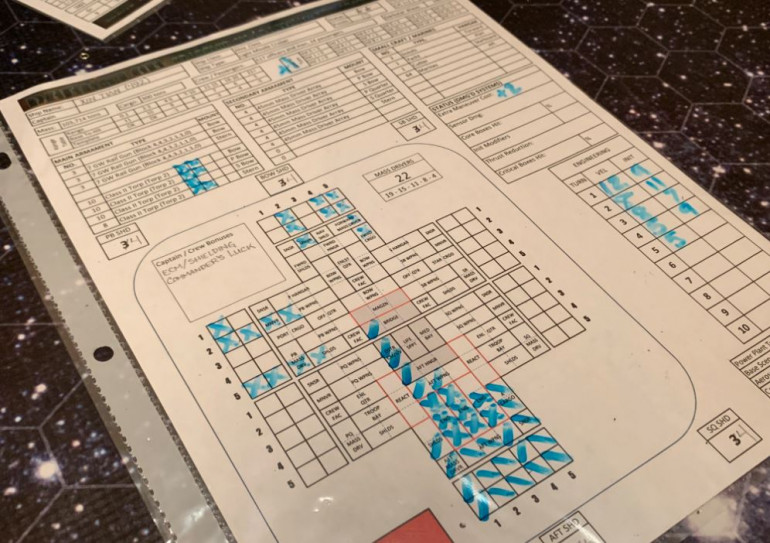 Fortunately for the Americans, the destroyers USS Oriskany and USS Valley Forge were broadsided across the fantail of the light missile cruiser Xin Tian (see US DD1 and DD3 across the tail of Black Dragon CL2 two pictures above). Two of my torpedoes hit, and then the gunnery of these two destroyers tears into what's left. This is especially true for USS Oriskany, upgraded +2 gunnery accuracy and +1 gunnery impact (all hits acre considered one range bracket closer). The bridge is hit, four boxes of core damage inflicted (60% chance the ship will have to flee) but eight boxes of red critical structure hit as well. A light cruiser is crippled on a 10+, -8 critical hits, = 2+ to cripple on a d6. I make the roll, and Xin Tian is now dead in space.
Fortunately for the Americans, the destroyers USS Oriskany and USS Valley Forge were broadsided across the fantail of the light missile cruiser Xin Tian (see US DD1 and DD3 across the tail of Black Dragon CL2 two pictures above). Two of my torpedoes hit, and then the gunnery of these two destroyers tears into what's left. This is especially true for USS Oriskany, upgraded +2 gunnery accuracy and +1 gunnery impact (all hits acre considered one range bracket closer). The bridge is hit, four boxes of core damage inflicted (60% chance the ship will have to flee) but eight boxes of red critical structure hit as well. A light cruiser is crippled on a 10+, -8 critical hits, = 2+ to cripple on a d6. I make the roll, and Xin Tian is now dead in space. 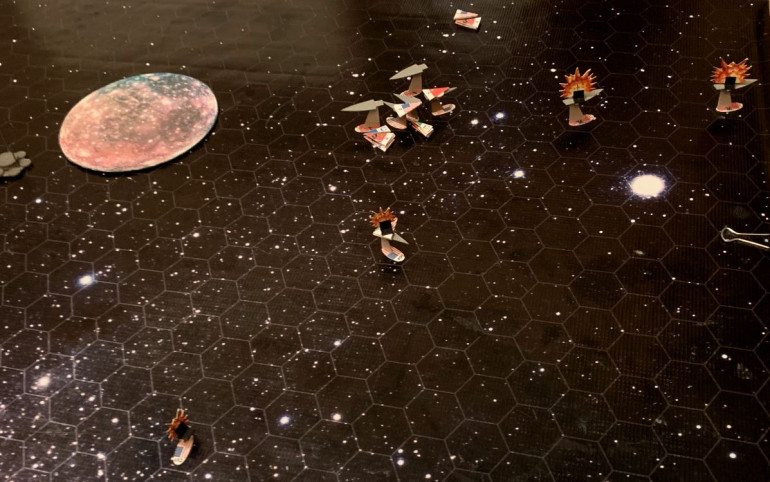 Turn 5, the last "dogfight." USS Daggerfish, USS Tarawa, KTS Tzarakin, KTS Xin Tian are all down. USS Oriskany, USS Princeton, USS Valley Forge, KTS Zhang Jia, and KTS Zharanyeva remain. At the extreme top of the picture, you can see where the Zharanyeva has re-launched her bombers, which are now set up for a second torpedo run on American warships, engaged in turn by my Navy and Marine Corps scouts.
Turn 5, the last "dogfight." USS Daggerfish, USS Tarawa, KTS Tzarakin, KTS Xin Tian are all down. USS Oriskany, USS Princeton, USS Valley Forge, KTS Zhang Jia, and KTS Zharanyeva remain. At the extreme top of the picture, you can see where the Zharanyeva has re-launched her bombers, which are now set up for a second torpedo run on American warships, engaged in turn by my Navy and Marine Corps scouts. 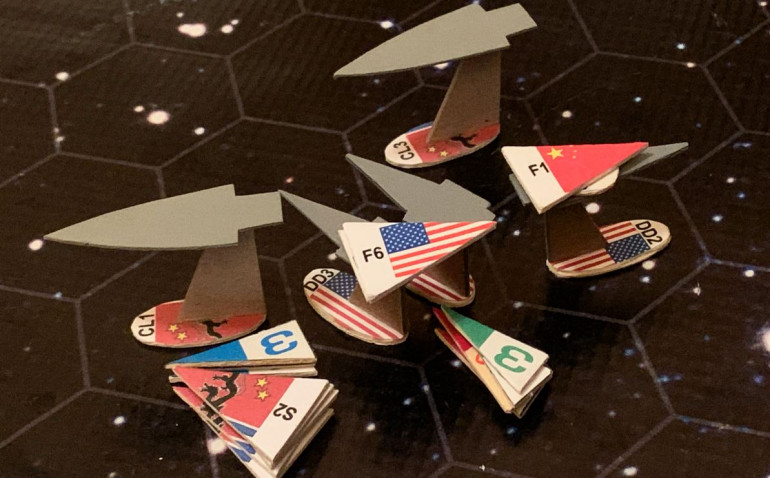 So here's a closeup of the last desperate brawl. DD1 = Oriskany. DD2 = Princeton. DD3 = Valley Forge. CL1 = Zhang Jia. CL3 = Zharanyeva (light cruiser-sized carrier)
So here's a closeup of the last desperate brawl. DD1 = Oriskany. DD2 = Princeton. DD3 = Valley Forge. CL1 = Zhang Jia. CL3 = Zharanyeva (light cruiser-sized carrier) Okay, here's the Turn 5 smackdown. USS Princeton shoots down one Black Dragon bomber (despite sensor damage and range penalties), that two less aerospace torpedoes coming at me this turn. The rest launch. These are far more dangerous than the slower Chinese and Russian-built warship torpedoes, so Oriskany and Valley Forge engage them with point-defense mass drivers first. Almost all are shot down, but several hit, along with some of the warship torpedoes (there are just too many of them, and USS Valley Forge doesn't have the same electronic warfare bonus as the Oriskany does). That, and elite or not, these are still JUST destroyers, and it doesn't take that much damage to knock one down. The Valley Forge is crippled! She's already fired into the stern of the Zhang Jia, however, along with the Oriskany, in a point-blank broadside. My Marine fighters went in for a gunnery run, followed by by torpedoes, most of which were shot down by mass drivers from the Zhang Jia (supported from the nearby carrier Zharanyeva) and also the remaining Black dragon scout planes. Meanwhile, my scouts butcher the rest of the Black Dragon bombers (after they released ordinance and helped cripple the Valley Forge, unfortunately).
Okay, here's the Turn 5 smackdown. USS Princeton shoots down one Black Dragon bomber (despite sensor damage and range penalties), that two less aerospace torpedoes coming at me this turn. The rest launch. These are far more dangerous than the slower Chinese and Russian-built warship torpedoes, so Oriskany and Valley Forge engage them with point-defense mass drivers first. Almost all are shot down, but several hit, along with some of the warship torpedoes (there are just too many of them, and USS Valley Forge doesn't have the same electronic warfare bonus as the Oriskany does). That, and elite or not, these are still JUST destroyers, and it doesn't take that much damage to knock one down. The Valley Forge is crippled! She's already fired into the stern of the Zhang Jia, however, along with the Oriskany, in a point-blank broadside. My Marine fighters went in for a gunnery run, followed by by torpedoes, most of which were shot down by mass drivers from the Zhang Jia (supported from the nearby carrier Zharanyeva) and also the remaining Black dragon scout planes. Meanwhile, my scouts butcher the rest of the Black Dragon bombers (after they released ordinance and helped cripple the Valley Forge, unfortunately).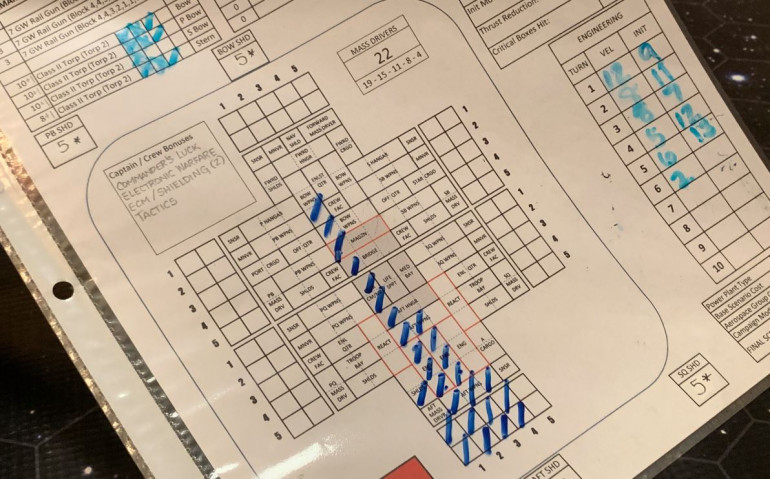 The damage sheet on the Zhang Jia. Marine fighters went in first, followed by torpedoes, then gunnery (per turn sequence). The bridge is hit, along with six boxes of critical components. Thus I need a 4+ to cripple, and happily I roll it. The Zhang Jia will be back, though, she has Commander's Luck and will eventually make her survival roll on the Warship Recovery Table. Villains this badass never go quietly into that good night!
The damage sheet on the Zhang Jia. Marine fighters went in first, followed by torpedoes, then gunnery (per turn sequence). The bridge is hit, along with six boxes of critical components. Thus I need a 4+ to cripple, and happily I roll it. The Zhang Jia will be back, though, she has Commander's Luck and will eventually make her survival roll on the Warship Recovery Table. Villains this badass never go quietly into that good night!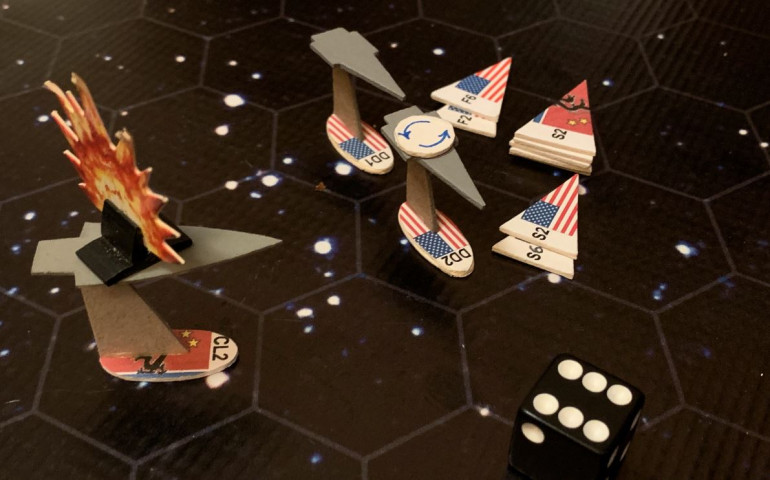 So now the only ships left are the USS Oriskany, and VERY badly damaged USS Princeton, and the empty carrier Zharanyeva. The Zharanyeva is powering off to the other side of the board to run out the clock for partial victory points, but the scouts are heading in for one last kamikaze effort to hit the unshielded side of the damaged Princeton. Jenn comes close here, she really does, but the one point of damage that actually gets in just doesn't hit in the right place, and of course all the scouts are massacred by mass driver point-defense and Marine fighters. The battle, finally, is over.
So now the only ships left are the USS Oriskany, and VERY badly damaged USS Princeton, and the empty carrier Zharanyeva. The Zharanyeva is powering off to the other side of the board to run out the clock for partial victory points, but the scouts are heading in for one last kamikaze effort to hit the unshielded side of the damaged Princeton. Jenn comes close here, she really does, but the one point of damage that actually gets in just doesn't hit in the right place, and of course all the scouts are massacred by mass driver point-defense and Marine fighters. The battle, finally, is over.So that’s the end of a 366-point Darkstar game. We did this in about 3 hours, but of course Jenn and I have been playing Darkstar for years and we buzz through the turns pretty quickly. The final score is a solid American victory.
Again, these are my “special baby” warships I have played at least several dozen times, some of them over 100 times. This was Jenn’s first try with these ships, classes, and designs. Trust me, these same Americans have lost their share of battles against the Black Dragons, especially the Zhang Jia and her consorts.
The Zharanyeva is still on the table = 35 points.
The Oriskany (104 points), Princeton (horrifically damaged but operational, half points = 37 points), plus 8 double-elite fighters = 32 points, 2 double-elite scouts = 4 points, 6 standard scouts = 6 points = 183 points total.
Americans win by 183 – 35 = 148 point margin.
146 margin required for “major” victory (40% of larger side’s 366 points)
So yeah, just barely, this counts as a MAJOR American victory in the Xi Scorpio War of 2516-18.
Thanks for reading!
Task Force Oriskany vs. Black Dragons (P1)
So with all the Darkstar wargaming that’s been going on lately in MS Excel / web conference, D20, and Tabletop Simulator, I thought I would actually *gasp* put some playing pieces on an actual game board and play a game of Darkstar old-school, with physical sheets and playing pieces.
Furthermore, I wanted to finally “put my own skin in the game” again, with none other than the Valcour class destroyer USS Oriskany (DSGN-797) and her task force (destroyers USS Princeton, USS Valley Forge, the Marine Corps aerospace carrier USS Tarawa, and Mako class torpedo corvette USS Daggerfish) in a full-consequence, live-opponent, “timeline canon” battle set back during the Xi Scorpio War last year.
I didn’t want to set it in the ongoing Duchess Annabel’s War between the British, Prussians, Russians, Panasians, New Romans, and other factions, as the Americans aren’t really a good fit for that conflict (it was honestly written for other factions)
Anyway, the opponent for the night would be the breakaway Sino-Russian rebels of the “Khitan-Tunguska” Free State (Black Dragons), one of the expansion factions.
The problem is, with the Oriskany and her task force so elite and so upgraded, their scenario point cost is very high, so in order to set up a balanced game, the enemy winds up with a lot of firepower.
Case in point: The Black Dragons will come on the table with the Slava class heavy cruiser KTS Tzarakin, the Xhia class light missile cruisers Zhang Jia (Oriskany’s hated rival), the Xin Tian, and the Gagarin-class light fleet carrier Zharanyeva.
Gladesrunner (Jennifer) has agreed to play the Black Dragons for the evening. In all, she outweighs me by at least 3-1, but both fleets are nearly perfectly balanced at 376-375. It’s gonna be a big game, with a powerful Black Dragon task force up against a small, experienced, elite, and fast American task force. Here’s hoping experience and technology and speed win out over weight, size, and firepower.
 So here is our imminent battle space. The game mat is 44 hexes long, representing about 8,000 kilometers of space. For reference, Planet Earth would be about 70 hexes in diameter, about one third of the planet would fit on this map.
So here is our imminent battle space. The game mat is 44 hexes long, representing about 8,000 kilometers of space. For reference, Planet Earth would be about 70 hexes in diameter, about one third of the planet would fit on this map. 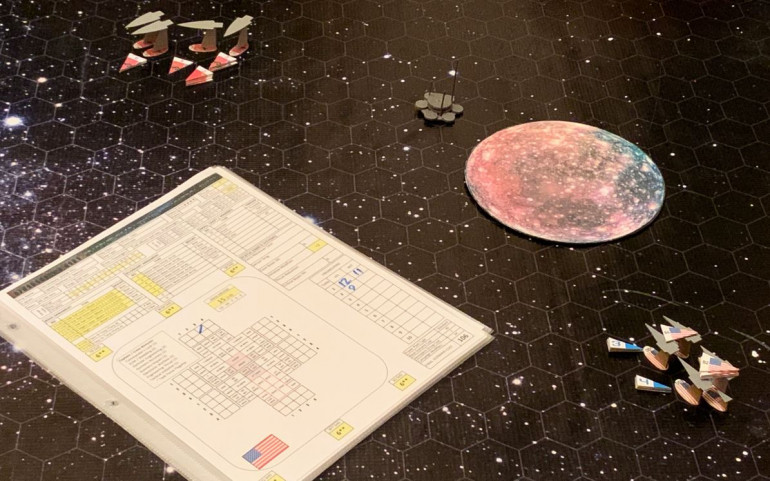 We make out initial approaches. The Black Dragons will almost always lose initiative (American ships are smaller, faster, have upgraded thrust, and ALL of them have the "Starship Tactics" Battle Upgrade). So after Jennifer brings on her Black Dragons, I bring on Task Force Oriskany, carefully using that small moon's bulk to screen me from two of the enemy warships. Basically, the heavy cruiser and carrier will not be able to fire guns or launch torpedoes at tme this turn, but all my forward guns and torpedo tubes can engage the two Xhia-class light missile cruisers. We exchange opening volleys and wouldn't you know it, the Oriskany herself takes the first point of damage on her bow.
We make out initial approaches. The Black Dragons will almost always lose initiative (American ships are smaller, faster, have upgraded thrust, and ALL of them have the "Starship Tactics" Battle Upgrade). So after Jennifer brings on her Black Dragons, I bring on Task Force Oriskany, carefully using that small moon's bulk to screen me from two of the enemy warships. Basically, the heavy cruiser and carrier will not be able to fire guns or launch torpedoes at tme this turn, but all my forward guns and torpedo tubes can engage the two Xhia-class light missile cruisers. We exchange opening volleys and wouldn't you know it, the Oriskany herself takes the first point of damage on her bow.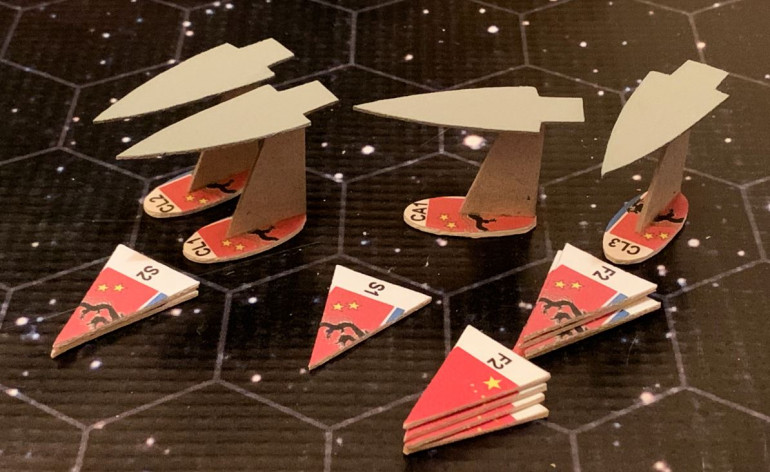 The Black Dragon fleet, having launched scouts, and a swarm of Russian-built fighters, bombers, and more scouts from the carrier Zharanyeva (CL3). CA1 = the heavy cruiser Tzarakin, CL1 = the Zhang Jia, CL2 = the Xin Tian.
The Black Dragon fleet, having launched scouts, and a swarm of Russian-built fighters, bombers, and more scouts from the carrier Zharanyeva (CL3). CA1 = the heavy cruiser Tzarakin, CL1 = the Zhang Jia, CL2 = the Xin Tian. 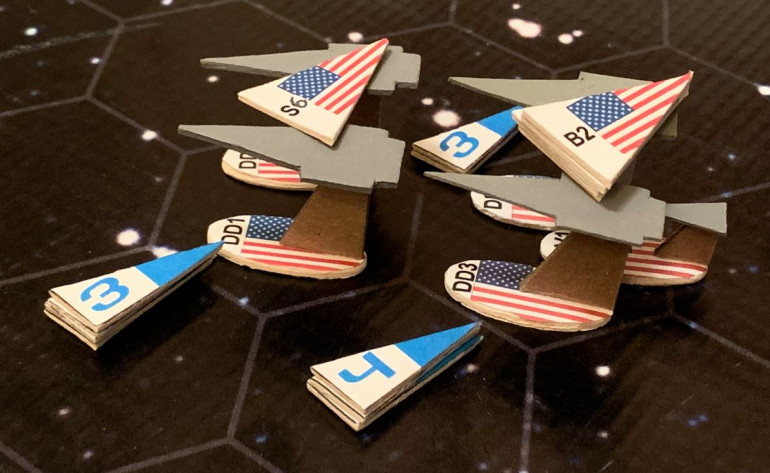 The American task force (much smaller ships), having launched torpedoes and Corsair fighters, Avenger torpedo bombers, and Hawkeye scouts. DD1 = Oriskany. DD2 = Princeton. DD3 = Valley Forge. DD4 = the USMC aerospace carrier Tarawa. CV1 = Daggerfish.
The American task force (much smaller ships), having launched torpedoes and Corsair fighters, Avenger torpedo bombers, and Hawkeye scouts. DD1 = Oriskany. DD2 = Princeton. DD3 = Valley Forge. DD4 = the USMC aerospace carrier Tarawa. CV1 = Daggerfish.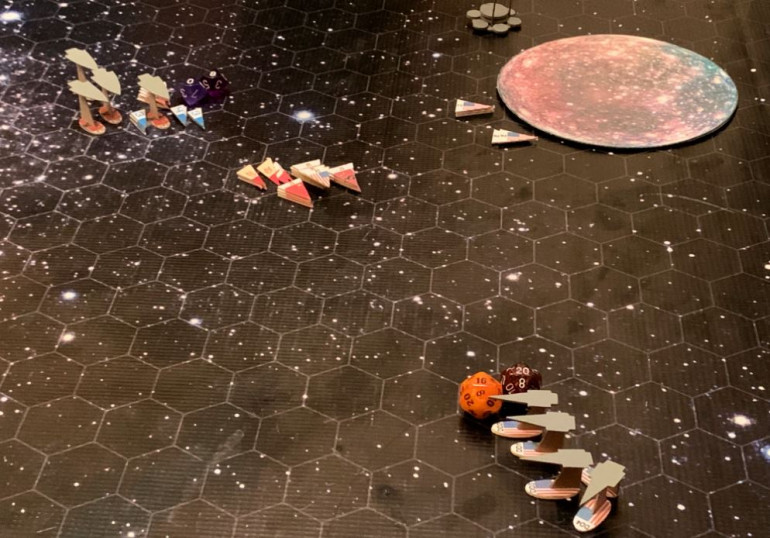 End of movement on Turn 2. The Oriskany Task Force has made a hard jack-knife turn to port, backing away from the oncoming Black Dragons. This is to outdistance the torpedoes fired from the Zhang Jia and Xin Tian, while my torpedoes hopefully hit the stern of their heaviest ship, the Tzarakin. Meanwhile, my Marine fighters and bombers are hugging the moon, set up just right to put their missiles and torpedoes into the Tzarain's tail as well. My scouts engage Black Dragon bombers, while Black Dragon fighters and bombers launch ordinance at the Princeton. I have two distinct advantages here. One, that jackknife turn means that Jenn will be unable to put her warship torpedoes and aerospace ordinance into the same strike, and again, two of the Black Dragon warships were unable to launch last turn anyway (I was hidden in the eclipse shadow of that moon).
End of movement on Turn 2. The Oriskany Task Force has made a hard jack-knife turn to port, backing away from the oncoming Black Dragons. This is to outdistance the torpedoes fired from the Zhang Jia and Xin Tian, while my torpedoes hopefully hit the stern of their heaviest ship, the Tzarakin. Meanwhile, my Marine fighters and bombers are hugging the moon, set up just right to put their missiles and torpedoes into the Tzarain's tail as well. My scouts engage Black Dragon bombers, while Black Dragon fighters and bombers launch ordinance at the Princeton. I have two distinct advantages here. One, that jackknife turn means that Jenn will be unable to put her warship torpedoes and aerospace ordinance into the same strike, and again, two of the Black Dragon warships were unable to launch last turn anyway (I was hidden in the eclipse shadow of that moon). 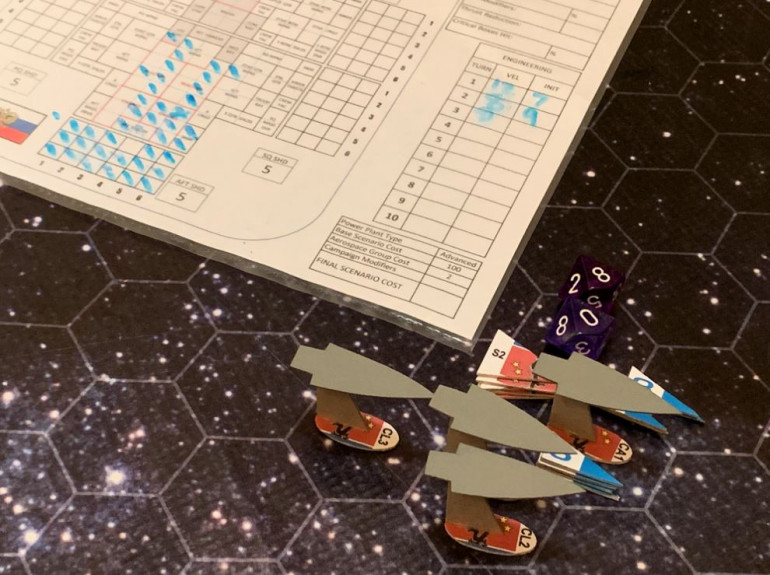 The results of my ordinance strike. Most of my warships torpedoes were shot down, either by Black Dragon scouts or mass driver defensive fire from those cruisers. Yes, USS Tarawa and specially Oriskany have Electronic Warfare battle upgrades that made this more difficult, but these are BIG enemy ships that just have walls of guns along their beams. However, this allowed by Marine aerospace ordinance to get through (hence, you always want to combine your ordinance strikes into single, massive waves). The damage on the Tzarakin was pretty severe, despite her heavy shielding and armor, and then I get pretty lucky on the hit locations. The damage chart shows were I hit no less than 15 critical structure boxes, meaning that not only is the Tzarakin crippled (no roll required), but there is a 20% chance she blows up right here, wiping out those scouts and burning off large slabs of armor off other Black Dragons ships. Jenn rolls a 36, however, indicating that the Tzarakin managed to eject her reactors before they went critical. The ship is just crippled, but didn't explode. One thing that really helped this ordinance strike is the fact that these Marine Pilots have been double-upgraded with "Elite Aerospace" - making them incredibly effective, and incredibly expensive.
The results of my ordinance strike. Most of my warships torpedoes were shot down, either by Black Dragon scouts or mass driver defensive fire from those cruisers. Yes, USS Tarawa and specially Oriskany have Electronic Warfare battle upgrades that made this more difficult, but these are BIG enemy ships that just have walls of guns along their beams. However, this allowed by Marine aerospace ordinance to get through (hence, you always want to combine your ordinance strikes into single, massive waves). The damage on the Tzarakin was pretty severe, despite her heavy shielding and armor, and then I get pretty lucky on the hit locations. The damage chart shows were I hit no less than 15 critical structure boxes, meaning that not only is the Tzarakin crippled (no roll required), but there is a 20% chance she blows up right here, wiping out those scouts and burning off large slabs of armor off other Black Dragons ships. Jenn rolls a 36, however, indicating that the Tzarakin managed to eject her reactors before they went critical. The ship is just crippled, but didn't explode. One thing that really helped this ordinance strike is the fact that these Marine Pilots have been double-upgraded with "Elite Aerospace" - making them incredibly effective, and incredibly expensive. 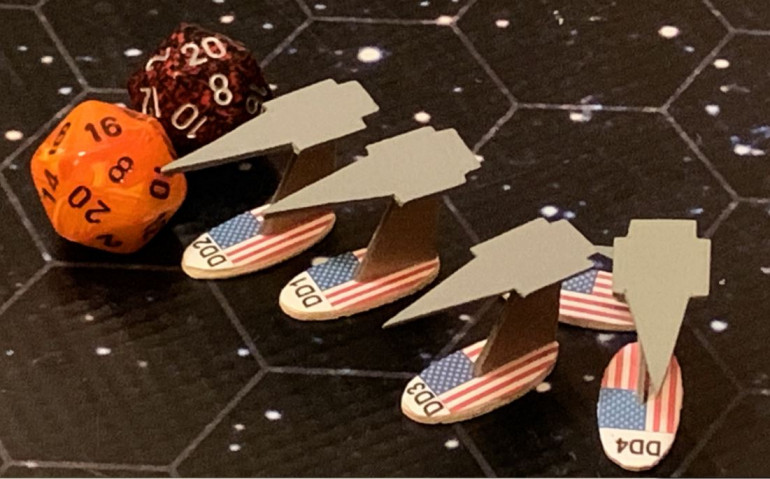 Twenty aerospace torpedoes and sixteen aerospace missiles are heading for the starboard bow of USS Princeton. But I have quite a bit of mas driver defensive fire myself, and while I don't have nearly as many guns, all my ships have at least a +1 CIC and some ships (Oriskany and Tarawa) also have electronic warfare battle upgrades. Then the surviving warheads have to hit the ECM and gravitic shielding of the Princeton, which has been battle-upgraded as well ... twice.
Twenty aerospace torpedoes and sixteen aerospace missiles are heading for the starboard bow of USS Princeton. But I have quite a bit of mas driver defensive fire myself, and while I don't have nearly as many guns, all my ships have at least a +1 CIC and some ships (Oriskany and Tarawa) also have electronic warfare battle upgrades. Then the surviving warheads have to hit the ECM and gravitic shielding of the Princeton, which has been battle-upgraded as well ... twice.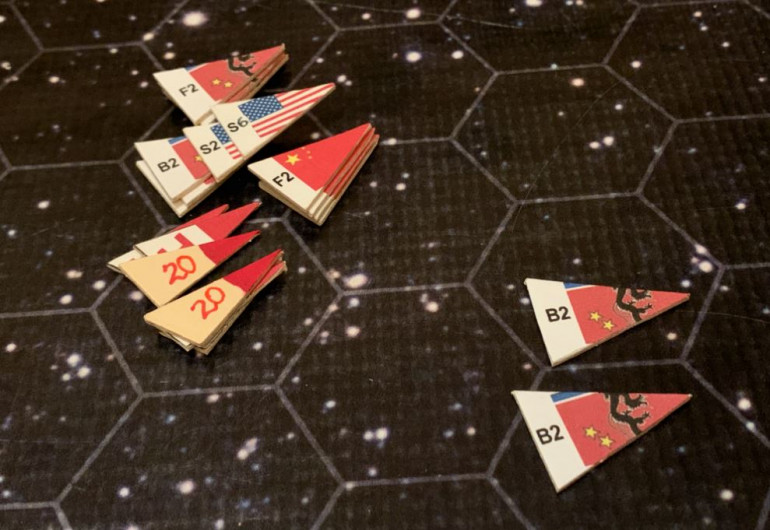 My scouts, meanwhile, engage Black Dragon bombers. Two of these scouts are double-elite Marines off USS Tarawa. The other six are standard skill level, two each off the Oriskany, Princeton, and Valley Forge. I take zero losses (these Black Dragon planes were all releasing ordinance at the Princeton), and four bombers are shot down.
My scouts, meanwhile, engage Black Dragon bombers. Two of these scouts are double-elite Marines off USS Tarawa. The other six are standard skill level, two each off the Oriskany, Princeton, and Valley Forge. I take zero losses (these Black Dragon planes were all releasing ordinance at the Princeton), and four bombers are shot down. In all honesty, perhaps a big part of the Americans' luck so far is due to my little mascot, Fillmore the Bald Eagle!
In all honesty, perhaps a big part of the Americans' luck so far is due to my little mascot, Fillmore the Bald Eagle! 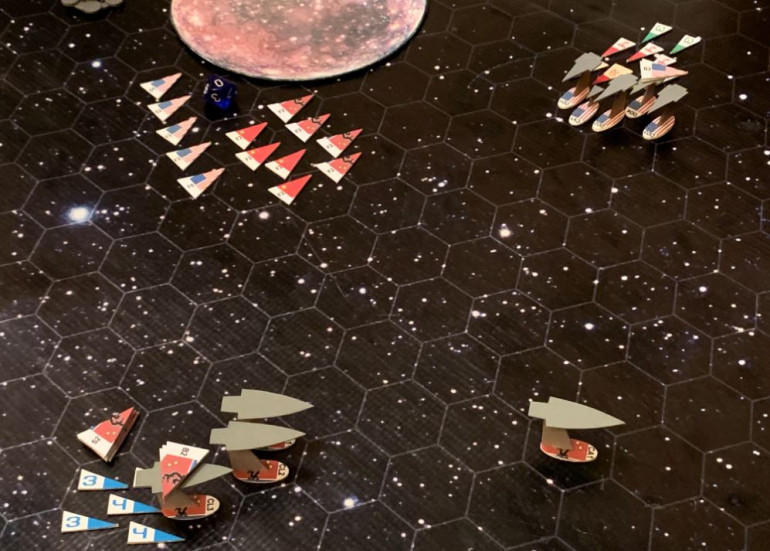 End of movement on Turn 3. As the Black Dragons rushed me, I again sidestepped, back near my original position, then fishhook turned around to present bow-on toward the enemy. Yes, I am giving away broadsides by doing this, but this allows me to present more torpedoes toward the enemy. Also, I should note that these American ships have been upgraded with additional Thrust, most "out of the box" can't move with this much agility. I should also note that USS Princeton will only be launching half torpedoes, as that Black Dragon ordinance strike heavily damaged her starboard bow, enough to tear out her starboard torpedo array and knock out some of her sensors. Last note: Check out the savage little dogfight of fighters near that moon, where sixteen Black Dragon fighters have engaged ten USMC FS/A-81 "Corsair" fighters and six "Hawkeye" scouts (Navy and Marine Corps). Again, the Black Dragons have the edge in numbers, but I have the edge in double-elite experience.
End of movement on Turn 3. As the Black Dragons rushed me, I again sidestepped, back near my original position, then fishhook turned around to present bow-on toward the enemy. Yes, I am giving away broadsides by doing this, but this allows me to present more torpedoes toward the enemy. Also, I should note that these American ships have been upgraded with additional Thrust, most "out of the box" can't move with this much agility. I should also note that USS Princeton will only be launching half torpedoes, as that Black Dragon ordinance strike heavily damaged her starboard bow, enough to tear out her starboard torpedo array and knock out some of her sensors. Last note: Check out the savage little dogfight of fighters near that moon, where sixteen Black Dragon fighters have engaged ten USMC FS/A-81 "Corsair" fighters and six "Hawkeye" scouts (Navy and Marine Corps). Again, the Black Dragons have the edge in numbers, but I have the edge in double-elite experience.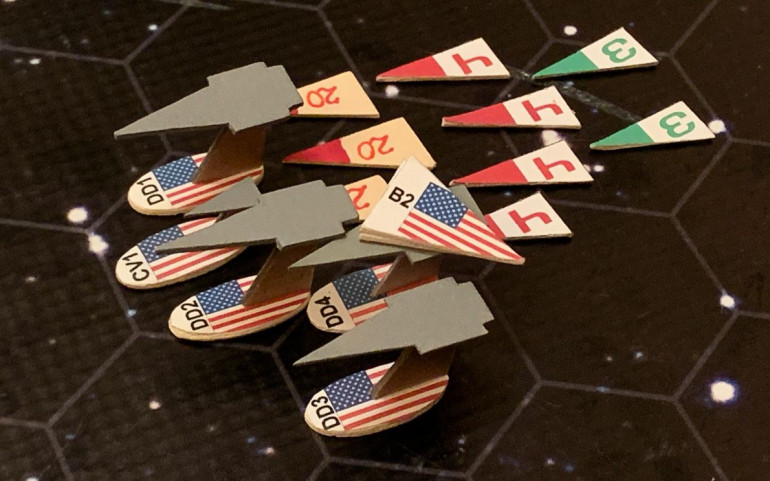 As the Marine bombers land back board USS Tarawa to re-arm and re-launch, we see the full power of a Black Dragon torpedo strike finally about to hit the stern of either USS Princeton, Oriskany, or Daggerfish. I can backpedal from these torpedo spreads for so long, so far I was able to break the Black Dragon's "Sunday Punch" into two smaller strikes, and delay the really big one by one turn (during which we crippled the Tzarakin). I just hope I've built up enough of a lead to carry me through the rest of the battle. The Americans of Task Force Oriskany have done great so far, but this battle is far, far from over, and the Black Dragons have finally closed the range to where they can start doing some serious damage.
As the Marine bombers land back board USS Tarawa to re-arm and re-launch, we see the full power of a Black Dragon torpedo strike finally about to hit the stern of either USS Princeton, Oriskany, or Daggerfish. I can backpedal from these torpedo spreads for so long, so far I was able to break the Black Dragon's "Sunday Punch" into two smaller strikes, and delay the really big one by one turn (during which we crippled the Tzarakin). I just hope I've built up enough of a lead to carry me through the rest of the battle. The Americans of Task Force Oriskany have done great so far, but this battle is far, far from over, and the Black Dragons have finally closed the range to where they can start doing some serious damage.Publication Complete, Donation Pool Closed
Good afternoon, OTT / Beasts of War.
Just posting a notification that publication for the new Darkstar v1 rules is now complete. Also, the PayPal Donation Pool is now closed, so I also wanted to post a final Thank You for the amazing support I received from the players. I use “amazing” here in the literal sense, what was given exceeded what I received by at least a factor of ten.
Seriously, guys and gals. You pushed an old man off his ass to finally do something he hadn’t wanted to do for over six years, and made it worth his while. For the donations, the support, the encouragement, and the motivation, thank you.
Meanwhile, the Darkstar rule book and first wave warships are now published and available for play.
And we’re playing on-line, live with the community, the supporters, and of course the game designer 🙂 every weekend! Just ping a PM if you’re ever interested, or if you’ve just watched old Star Wars, Star Trek, or BSG episodes and really wondered . . .
. . . would I have what it takes to command starships in combat?
Talk to the people who have tried this game.
See if they have found the answers to that question.
New British Heavy Cruiser Playtested Live! (P2)
Duchess Annabel’s War continues in Darkstar, where a Royal Navy battlegroup, originally built around the Trafalgar class heavy cruiser HMS Bellerpheron (played by Damon), faces off against an intruding Imperial Prussian battlegroup led by the Leopold class heavy cruiser KMS Lutzow (played by myself).
So far we’ve seen the Prussians make a very fast approach, eager to close the distance against more accurate, longer-ranged British guns. The British made a dive toward the planet, peeling off in the nick of time in an effort to get behind the Prussian warships. In so doing, however, the British allowed the Prussians to “cross their T” for a moment, all they needed for a gigantic broadside of Prussian rail guns (x8 11-gigawatt rail guns, x20 6-gigwatt rail guns) to shred the escorting destroyer HMS Essex. The Essex has been crippled, her skipper perhaps dead or dying.
But the Bellerpheron has responded, knocking out one of the Lutzow’s maneuvering thrusters, making it all the more inevitable that the British heavy cruiser will be able to rake the big Prussian’s stern and cripple her as well. If Damon can trade a destroyer for a heavy cruiser, he’ll have this game all but won.
Now, the Lutzow loses initiative again (predictably – she has a slower thrust envelope because her power-weight ratio is lower than that of the Bellerpheron. Also, making turns at this speed will be twice as hard as she has lost one of her maneuvering thrusters.
Nevertheless, determined to survive, Lutzow powers up out of the planet’s gravity well, spending two thrust points to painfully roll over on her back, thus shielding her damaged starboard quarter away from the Bellerophon. But the Bellerpheron will not be denied her vengeance. Still moving at 24 kilometers per second (8 hexes a turn), she powers her 146,000-ton bulk in a tight s-turn (against planetary gravity), then using the planet’s gravity to tug her back into position directly behind the Lutzow, presenting a full broadside into the Prussian’s engines at less than 550 kilometers (pointblank range for heavy cruiser weaponry).
The Lutzow opens fire with her two aft turrets of 11-gigawatt rail guns and two aft turrets of 6-gigawatt rail guns. This is the first damage the Bellerpheron has taken this game, her starboard bow hammered by the big Blohm & Voss magnetic rail guns. There is internal structure damage, and the starboard hangar is knocked out, but casualties are light and Bellerpheron suffers no immediately critical damage.
With all turrets presenting a full starboard broadside, the Bellerpheron roars. It cost the Royal Navy a destroyer and dozens of lives to get her into this position, this single broadside could well determine the game. And the Lutzow has stronger gravitic shielding protecting her stern, just for this very reason. But this close, and with the Bellerpheron’s Hawkinge Electronics 01A (+1 targeting CIC) fire control system, almost everything hits. Most of the EPCs hammer into the port side of Lutzow’s stern, completely tearing apart the portside engine assembly and exploding the aft mass driver array completely out of the hull. Portside reactors take a hit, and even life support systems are hit, knocking out artificial gravity and atmospheric controls for Lutzow’s 768 officers and men. Fires burn out of control throughout engineering, further depleting breathable atmosphere. Fire control teams in oxygen masks fight to control decompressions and fires, while the bridge crew tries to reroute reduced power output solely out of the starboard reactor and engine.
It doesn’t work. Lights aboard the KMS Lutzow flicker and die, and the burning ship is now careening and adrift in space, trailing a long sheet of glowing molten metal and escaping, burning atmosphere.
In game terms, note that Damon has knocked out 9 “red” boxes of critical internal structure. The Lutzow is a heavy cruiser, and so her “target to cripple” on a d6 starts at a 14+. From that number, the 9 critical boxes are subtracted, leaving Damon with a 5+ chance during Turn 3’s resolution phase. He nails a 6, crippling the Lutzow.
However, referring back to the map, we see that the two Prussian frigates Jenna and Koblenz have kicked their engines almost full reverse, letting the planet’s gravity guide them almost directly behind the Bellerpheron. Now their guns can never defeat the huge Bellerpheron (she outweighs each of these frigates almost 7-1), but they do have torpedoes, as does the little Prussian Type XII umfangangriffboot (perimeter attack boat) U-126. And without the Essex to escort her, the Bellerpheron is going to have a much tougher time shooting all of these down. The British scouts and fighters do their best, while the Prussian scouts fail to shoot down any British scouts. But five of them survive, and two of them get through Bellerpheron’s shields to strike directly against her stern armor.
Next come the rail guns and deck laser of the frigates and corvette. These actually score spectacularly well (they are in the same hex after all, perhaps as close as 50 kilometers). But the damage all tracks way to port, missing all the Bellerpheron’s engines and reactors (although the Prussians do hit the “CREW FAC” in column 1, putting a rail gun bolt through the Bellerophon’s pub. Bad form!
The Bellerpheron tries to pull away. Her captain for a moment considers chasing down and finishing off the Lutzow forever, but he’s still bound by orders to defend Vancouver Station. Bellerpheron turns to starboard, but the much smaller Jenna, Koblenz, and U-126 can easily match the move, remaining on Bellerpheron’s damaged stern. More torpedoes and rail guns are sent in, even as the tiny Jenna is cruelly charred by Bellerpheron’s aft EPCs and lasers. This time the Prussian hits track further to Bellerpheron’s starboard, eventually knocking out the medical bay.
Now here is where British luck at last gives out completely. In the damage chart below, note where two “core” boxes have been hit (gray). This causes the Bellerpheron to make a “breakoff” check. But heavy cruisers only have a 10% chance of breaking off per core box hit. So with two boxes, Bellerpheron only has a 20% chance of failing that roll.
But Damon rolls percentile 07. Perhaps it was the screams of dead and dying from the medical bay (really the only crew losses the Bellerpheron has taken so far) that compel the officers of Bellerpheron to break off the engagement. Perhaps Vancouver Station has now been evacuated, and further bloodshed now seems pointless.
In game terms, the Bellerpheron must now change course for the closest non-planet corner of the map, and she is now allowed to decelerate. It will take one more turn for her to each it and leave the map (then punching the Darkstar FTL drive, perhaps after rescuing survivors of the HMS Essex). This allows a second aft barrage to hit KMS Jenna, burning through the little frigate’s bridge (wounding but not killing the skipper – a “4” rolled on the Captain Survival Table). Lasers then hit the little corvette U-126. One laser hits the port bow, straight toward the corvette’s bridge. If Bellerpheron’s other aft laser hits there as well, the corvette will also be crippled. But it misses, leaving the tiny U-boat damaged but operational.
The last volley of fire from the three Prussian ships, like wolves attacking a wounded bear, actually cripple the Bellerpheron as she’s leaving the table at the end of Turn 5. In column 1, you can see where one of Koblenz’s torpedoes actually exploded all the way through the back of the ship, and out the bow. Yet amazingly, only two core boxes are hit, and thus crew casualties aboard the Bellerpheron will actually be very light (she carries 677 officers and men in all).
Note this damage chart reflect three successive broadsides of all three remaining Prussian ships, plus three torpedo spreads, all right in the stern (plus Lutzow’s original aft guns into her port bow). By now the two Prussian frigates are almost out of torpedoes, while the U-126 is completely out of torpedoes.
The final result. With only a frigate, corvette, and four scouts left, Prussian score is 20 + 12 + 4 = 36 points. The British have 4 scouts and 2 fighters = 8 points, giving the Prussians a 28 point victory (15.9%). This definitely gives them Vancouver Station, but by no means is considered a “major victory (a margin of 40%+ is required for that, per Rule 5.2.1.C.iii, p. 99). The Prussians are too busy getting tugs and rescue ships out to the Lutzow and solidifying their hold on this new station / moon / planet – they certainly won’t be immediately exploiting this success deeper into this British-held star system.
Speaking of post-battle resolution – we were just clowning around after the game and Damon actually failed the recovery check on HMS Bellerpheron. So I’m considering that first roll that would actually have to be made in this game, the Captain Survival Check for the skipper of HMS Essex (bridge completely knocked out). The commander of this ship, Commander Lawrence Book, sadly died when those rail guns went through the bridge. But the Bellerpheron would eventually be recovered, as would the Essex herself. Meanwhile, the Lutzow and Jenna would also be safely recovered and brought back to service, although the Lutzow will require 34 days in dry dock to be ready for action again, if they can repair her at Vancouver Station. If they have to tow her back to another station, God only knows how long it will take for her to limp back there (Rule 5.4.6.B.ii stipulates 3 days per light year, this could be as much as another month just in tow time).
In all, a great game, one for “canon” in the ongoing Duchess Annabel’s War. 😀 The Prussians squeaked by on this one, but trust me, with the hammering the Russians and British have been giving them in this war so far, they have quite a deep hole to dig their way out of.
As far as post-battle advice goes … the move to get behind the Lutzow was a good one, but my Americans and Japanese have fought many battles against Russian K-56 torpedo corvettes. They take maybe 1-2 “big gun hits” to cripple. Knock that U-boat out early when the ranges are still a little long, you’ll never outmaneuver her in a close-up dogfight. If if she was out, you Bellopheron never would have gone down to the torpedoes of the Jenna and Koblenz.
New British Heavy Cruiser Playtested Live! (P1)
The Darkstar universe continues to gain momentum as another on-line game was run live on Sunday, January 6. This time we had Damon from the UK on with us, along with a gallery on onlookers including several prospective new players and @aras , one of the original playtesters of the Darkstar system from all the way back in 2012.
As always, if you’re interested in this wargame, we play live online almost every week Just ping me a PM with an e-mail address if interested. Also, the rule rook is available for download: here
Damon was hoping to test out the new heavy cruiser design he commissioned as part of the Darkstar Rule Book v1.0 Project, the Trafalgar class heavy cruiser. This class breaks with several traditions of the Royal Navy, foregoing conventional rail guns for the electron particle cannons, cutting back slightly on secondary armament and protection in the interest of enhances sublight thrust and maneuverability, and increased anti-aerospace protection from enemy fighters, bombers, and torpedoes.
All heavy cruisers of the Trafalgar class are named for warships that were with Nelson during the historic Battle of Trafalgar in 1805. So for today, Damon has HMS Bellerpheron, escorted by the Falklands class destroyer HMS Essex. His mission is to come to the aid of an undefended British installation in high orbit over a Mars-sized planet, somewhere in them much-embattled Libra-Sagittarius strategic command sector, combat zone of the ongoing Duchess Annabel’s War. It seems the Prussians from the Eisenwolf colonies (Gleise 570) are getting uppity again, despite the thorough pounding they received from a joint Russian-British Task Force at the recent Battle or Cervantes (Mu Ara).
So here’s our battle for the day. We see the British “Vancouver Station”, launching two fighters (balancing out the game, the British needed 4 points). From above the planet’s north pole, we see Damon’s battlegroup. At lower left, still decelerating from their Darkstar Wave, we see the Prussian force.
Clearly the Prussian Force is more numerous. We have the Leopold class heavy cruiser KMS Lutzow, along with two Emden class frigates an a Type XII class umfangangriffboot (perimeter attack boat, or U-boat) U-126. While the Lutzow and the Bellerpheron are both “advanced” heavy cruisers (120 points), the difference is in the HMS Essex. She’s an advanced destroyer (48 points), while the Jenna and Koblenz are standard frigates of 20 points each. Add the U-126 and the game comes out at 176 points, once we balance things out by giving the Britsih a fair of Supermarine Starfire fighters launching off of Vancouver Station.
With her faster speed, the Bellerpheron win initiative and so gets to move second. The Prussians, still moving very fast (especially for a heavy cruiser) zoom on at 36 kilometers a second (12 hexes a turn), hoping to close the distance as quickly as possible. The Prussians have many more guns than the British, but they are less accurate (both Bellepheron and Essex have +1 CICs) so it behooves them to get the shooting ranges short as quickly as possible.
That said, the Prussians also have to maneuver, and the Lutzow is a ponderous beast, so they’re also standing on their brakes as they streak toward Vancouver Station, accounting for the planets gravity as they go (one hex pulled toward the planet at the end of their movement if you end movement within 10 hexes of a the planet). Initial shots are exchanged, nothing much. At this extreme distance (19-21 hexes, about 3700 kilometers).
The Prussians, still slowing, now have enough thrust to make a hard turn to port, hopefully presenting a broadside toward the approaching British. The Lutzow has the lowest power-weight ratio on the table, resulting in the lowest thrust, meaning she will usually lose initiative (especially when she keeps rolling 2s). When you lose initiative and have to go first, all you can hope for is to predict where you think the enemy might be at the end of their movement, ased on their position, bearing, speed, and available thrust.
The British, seemingly strangely at first, actually streak toward the Prussians at pretty high speed. Bellerpheron dives at the planet at 24 KPS, pulling out two hexes away so that when gravity is accounted for, he’s still one hex away, just enough to avoid burning up in the planet’s atmosphere. Essex follows suit, screening ahead of the cruiser, the port sides on both British ships perhaps glowing a faint, dull read as they literally “bounce” off the planet’s atmosphere.
The Prussians, for the moment, can’t believe their luck. Even though their flagship lost initiative, they have successfully (albeit barely, sloppily) crossed the British T. Every single Prussian gun in the battlegroup will be able to shoot this phase, while, the British can only respond with forward guns. But there is method to the British madness. In true “Nelson fashion,” although Bellerpheron may take a hammering this turn, next turn she will be all certainly directly behind the Lutzow, firing powerful 15 terevolt EPCs directly into her vulnerable engines and reactors.
While guns come to bear, torpedoes streak toward their targets (blue and red wedge pieces). Here the Prussians have a huge advantage, especially with that U-boat on the table (eight forward-firing torpedo tunes, plus a +2 targeting CIC). But the Bellerpheron bristles with 25mm mass driver chain guns, and between her guns, those of the Essex, and the scouts and fighters, they shoot down every Prussian torpedo as they streak in toward the engines of the Essex.
The shooting begins. Knowing they won’t be able to knock out the Bellerpheron in one salvo (at least from the bow, there are just way too m any armor and internal structure boxes to get to before you start hitting vitals like the forward magazine and the bridge), they instead focus everything on the hapless Essex.
At a range of just over 1000 kilometers (spitting distance for a heavy cruiser), the Lutzow fires everything she has at the British destroyer. Eight 11-gigwatt rail guns, then twelve 6-gigawatt rail guns. A Falklands class destroyer is fast and high-tech, but not terribly robust. She simply comes apart under the hail of fire, especially once the two frigates add their own smaller rail guns to the argument. The Essex is simply shredded, damned near split clean in half longways by the concentrated Prussian rail gun fire. Once the bridge is hit the ship is already crippled, but the rest of those Prussian guns have already fired and to be honest it’s a bit of overkill. Suffice it to say the Essex is out of the fight.
If there’s one thing Prussians do well, it’s rail guns.
The Bellerpheron and the Essex, meanwhile, try to give as good as they get. They have two disadvantages at the moment, however. One, they Lutzow has stronger shielding on her hind quarters (British guns come to bear on the Lutzow’s starboard quarter), and only their forward guns can fire. Still, they manage to open a terrible gash in the side of the Prussian beast, and perhaps most significantly, knock out her starboard quarter maneuvering thruster. This means the Lutzow will have to pay +1 Thrust for every turn she wants to make. Already badly outclassed maneuver-wise by the Bellerpheron, and with the Bellerpheron practically on her tail already, the Lutzow is indeed in trouble next turn.
So can the British pull this one out of the fire? Or is the British winning streak about to be finally broken? Can the Lutzow and her escorts turn around Prussian fortunes in Duchess Annabel’s War?
AAR: Rasmus (Japanese) v. Oriskany (Russians) P1
Hello, OTT / Beasts of War. It’s time for another battle report for a Darkstar game run between myself as Rasmus earlier in December. With the holidays behind us and a new year underway, these weekend web games are off and running again, so if you’re ever interested, PM me with an e-mail address to which I can sent a web conference link.
Also the Darkstar rule book and first wave warships are now published and available for play.
We also have another game scheduled for Sunday, where Damon tries out his new Trafalgar class heavy cruiser against the rival Leopold class, a rail gun beast sailing under the flag of the Imperial Prussian Kriegsmarine.
But for now, let’s get started with the battle report.
Rasmus reached out to me and said he’d like to take a swing at Darkstar, specifically the high-tech Japanese. Some Japanese warships are decidedly low-tech (modeled on the World War II Imperial Japanese Navy, a curious blend of visionary technology and doctrine and hidebound traditionalism), but for the battle I set him up with a Taiho (Great Phoenix) class light cruiser and a Takashiro class destroyer (high-tech destroyer not included in the first wave warships).
In fact, these ships were so high-tech (enhanced engines, greater thrust, +2 targeting systems), that I was able to afford not only a light cruiser and destroyer of my own (Holy Russian Empire, Kutusov class and Sovnya class, respectively), but also a small Novgorod class frigate.
Thus we wound up with a modest 135 point game. Just enough for fun and to let a new player get his feet wet in the Darkstar system.
So here we see the approaches. Two United Nations orbital platforms are in dispute around this roughly Mars-sized planet(6700 km, 37 hexes in diameter). Russians are coming up from the south pole / night side, Japanese are coming down from the north pole / day side.
While the Russians aren’t exactly low tech (all their ships are “Standard” engine class for their ship type), the Japanese are higher-tech. Both the light cruiser Nagara and destroyer Arashi are “next-gen” engines, with +2 targeting / CIC systems, and enhanced thrust for their class (which will also give Rasmus a bonus on initiative). The balance is, as usual with Russian forcesm numbers. More “generic” tech makes my ships less expensive, which means I can afford that extra frigate. Also, my ships have more guns than his. Not as accurate or as long ranged, but more of them.
At a range of just under 2000 kilometers, the two fleets open fire. As predicted (due to higher thrust and thus more agile ships), Rasmus’ Japanese largely won initiative, forcing me to go first. So I set a very high approach velocity, decelerating just enough to make a port turn just before hitting those asteroids (hopefully using them as at least some kind of cover). The Japanese, for their part, are carefully using the range brackets to their advantage, staying at 11 hexes away (thus putting us at the 11-15 range bracket) so my guns are far less accurate than his.
Both sides launch torpedoes and scouts, and we are off and running!
It seems as if my Russians and Rasmus’ Japanese were a little too keen to come to grips with each other. While I still kept decelerating as fast as I could (not easy when you enter the board at 48 kilometers per second), the Japanese have spent more of their thrust in turns, and thus are also going too fast.
Then again, with the Russians pushing toward them so aggressively (it’s to my advantage to close the range as quickly as possible, where Japanese technology matters less and my numbers matter more), Rasmus’ best play is not to slow down and back off, but keep going fast as zoom past my Russians.
It’s a risky maneuver, he’s heading straight toward some asteroids and his engines / fantail are now exposed to my plasma projectors, rail guns, EPCs, and swarm of P-500 “Plamya” (Flame) torpedoes . . .
The first huge blows land, and first blood is drawn! The Russian P-500 warheads streak in, shot down in droves by accurate Japanese mass driver fire. There are also three Japanese Ki-202 “Hien” (Flying Swallow) scouts, who manage to shoot down a few more incoming torpedoes.
But out of 22 warheads, 7 have survived to hit the Nagara’s shields. Four get through, and sure enough, the Russians catch a break with the hit locations on the Nagara’s stern. Two torpedoes smash through the armor and into the engines, two more explode through these same engines and into the reactors. EPC fire is next from the aft batteries of the Lazarev, as well as plasma projectors and rail guns from the destroyer Kortik and the little frigate Volkhov.
It’s too much for the Nagara. Seven boxes of critical structure have now been hit, and the d6 roll to cripple a light cruiser is 10+, minus the number of critical structure boxes struck. 10 – 7 = 3, so I have to roll a 3+. I beat the roll during Resolution Phase, leaving the Nagara crippled and adrift . . .
. . . at least until she hits that asteroid field. Hopefully the crew had enough time to abandon ship. But the Nagara herself is gone, blown completely apart in a hail of asteroid impacts.
In the same turn, however, the Japanese torpedo spread is heading for the tiny frigate Volkhov. These are some of the deadliest torpedoes in Darkstar, V Ki-45 “Toryu” (Dragon Slayer), and the Volkhov was already damaged somewhat in the battlegroups’ initial approach and flyby. The little frigate is positive blown inside out, but technically is only “crippled” and could conceivably be recovered and eventually repaired, depending on how this battle turns out and how lucky she is on the Warship Recovery Table.
Meanwhile, Japanese gunfire tears into the starboard quarter of the Lazarev. There aren’t very many Japanese guns, and they aren’t even particularly strong, but they are accurate as hell as hit with a very long reach. Rasmus also gets lucky with lit locations, soon decompressing and destroying the Lazarev’s aft hangar. These are “core” structure boxes, and with three of them hit, Lazarev has a (3 x 15% = 45%) chance of being forced to break off. Sure enough, I fail the roll, and the Lazarev must now flee the table.
Basically, the cruiser took sufficient personnel losses and failed a “morale check.”
So now we’re down to just a destroyer each. That didn’t take long. The exception is that while the Lazarev is forced to flee, while she’s doing this she can continue to fire guns and torpedoes. So I might be able to squeak out a win here.
But the nimble Arashi hits the brakes, decelerating enough to execute a couple fish-hook turns and stay behind the asteroids, using them as cover while the Lazarev is forced to flee the table and some of her own torpedoes might land a lucky hit on the remaining Russian destroyer Kortik.
The deathmatch between the Kortik and Arashi gets underway on Turns 4 and 5. The Japanese destroyer is faster and more accurate, but the Russian ship has more, punchier guns and heavier shielding, she’s just tougher and meaner. There’s no way Rasmus is going to beat me here with guns, but he just might do it with torpedoes. Good thing those Sovnya class destroyers have lots of mass drivers for anti-torpedo defense . . .
AAR: Rasmus (Japanese) v. Oriskany (Russians) P2
. . . at least until I roll a “1” on mass driver defense and three of Arashi’s Ki-45 torpedoes slam into my fantail. That’s all she wrote. This came really close, actually, the Arashi by now had been hammered by close-range Russian 7 GW rail guns and 40 KG plasma projectors for two turns, she is definitely worse for wear.
But with the Kortik now crippled, the Arashi remains the only operational warship in the area and technically this is a Japanese win.
The hapless Volkhov, having been hit between the eyes by three Ki-45s. The orange damage was inflicted the previous turn by Japanese gunnery during the initial approach. The cavitation of Class V torpedoes is clearly visible. The 25,000-ton ship was damned near cored like an apple.
Even worse is the light cruiser Nagara. You can see where the Russian torpedoes slammed into her centerline and starboard side engines, exploding forward through the aft gun turrets, hangars, and finally into the med bay. But once she lost power, this was all a moot point, as she was moving at 30 km per second with asteroids 3 hexes away (540 kilometers). This meant that the crew had about 18 seconds to abandon ship. After that, there are no survivors.
The final situation, with the Kortik crippled and the Arashi standing tall to land troops and take possession of those UN orbital platforms. The results are a little uncertain, however. Viewed as a standalone game, Rasmus and his Japanese clearly won, with an operational 48-point destroyer still active in the area. Suffice it to say the Japanese definitely own those two orbital platforms.
But in any kind of campaign setting, this might actually be a Russian win. The frigate Volkhov fails her recovery check, and is considered lost (scuttled by the crew, probably before being boarded by Japanese marines). But the Kortik succeeds, and will thus return to the battle. So the Russians traded a 20-point frigate for the IJN Nagara, an expensive 84-point light cruiser. Yes, the Russians lost the chance to grab those stations, but there’s nothing to say (in a campaign setting) the Lazarev and Kortik won’t be back to take them from the lone Arashi.
In a word, the Japanese won the game. The Russians won the battle.
We have another game scheduled for Sunday, where Damon tries out his new Trafalgar class heavy cruiser against the rival Leopold class, a rail gun beast sailing under the flag of the Imperial Prussian Kriegsmarine!
Darkstar v1 Rules Published for Everyone!
Good afternoon, OTT / Beasts of War:
Okay, I am officially publishing for general download the v1.0 rules for Darkstar, my tactical starship combat game.
With the background and “lore” previously made available in this thread, this reference is “nutz n’ boltz roolz” for basic, general gameplay, along with the write-ups and warship records sheets for 30 classes (including gunboats, corvettes, frigates, destroyers, light and heavy cruisers, battleships, and carriers) of the six of the most popular factions.
The .pdf is 146 pages, and also includes sample scenarios, tons of illustrated examples, designer’s notes, rules for upgrading your starships and commanders and helpful hints for your first few times trying the game.
The link is above. If you’re interested and don’t have access to it, please PM me with your e-mail address or e-mail at [email protected].
DARKSTAR RULES & WARSHIPS COMPLETE
Backers and supporters have been e-mailed with their .pdf copies of the finished book.
If you supported my PayPal Pool and do not have a book, or cannot access it, please ping me on this thread or via PM and I’ll get it sorted.
General-access to the community at large will come in the next week or so.
Forty days of nearly constant work – from November 18 to December 29 – are finally complete. It was as exhausting as I thought it would be, but it feels so good to finally have it done.
Darkstar Rules & "First Wave" Warships to Publish This Weekend!
Both rules and “first wave” warships ware now complete (30 classes in all) – with write-ups and Warship Record Sheets for print & play.
Just converting to .pdf, and of course I want to design a cover. 😀
Backers / Contributors will get access to the rules first, hopefully within the next 24-36 hours. If all goes well, look for an e-mail soon!
And woo-hoo! Over 2000 recommendations!
Proofreading 50% complete, Ground Broken on "First Wave" starships
Good afternoon, everyone.
Okay proofreading (formatting, tweaks, cross-indexing, etc) on the Darkstar rules is 50% complete. I also want to add copies of the turn sequence and the Quick Reference Sheet. I won’t add a table of contents as again, this will be eventually stitched together into a full Darkstar reference book of well over 200-250 pages, and for that I will have a complete ToC.
Also, I’ve broken ground on the ships that will be included for “Wave One” release. The list of classes is finalized, now it’s just a lot of formatting and proofreading, etc.
The rules will be done by Christmas.
The ships I hope to have complete by New Years.
So the combined rules and ships .pdf may not arrive until New Years.
Just to keep everyone up to date. 😀
Rules - First Draft . . . D.O.N.E.
Just a very fast update – The Darkstar rules, at least in their first draft, are done.
60 pages – and that doesn’t include the 28 warship designs (six factions) I’ll be rolling out with the “first release.”
Of course, I’ll want to breeze through these at lest once for proofing, formatting, cross-indexing, and clarity tweaks.
Again, the goal here is to get a combined .pdf (this will be over 100 pages) put together before Christmas (??) or at least the New Year. And again, it will still be something of a draft, definitely a “living document” that may be updated later for corrections if nothing else.
There’s light at the end of the tunnel!
Update … added Designer’s Notes … make that 64 pages, plus (28 x 2 = 56) pages of warship record sheets and write ups = 120 pages + 7 pages of blank records sheets for players to use = 127 total pages …
New "Aerospace Guard" Warships: Clarino Class
Good morning Beasts on War / OTT:
I’m happy to roll out a new warship class requested by another Darkstar contributor, who had the honestly fantastic idea of including references to the United States Coast Guard as well as the US Navy the future American “navies” of the Darkstar universe.
So this class actually has two variants, one for the United States Aerospace Guard (spiritual descendants of the US Coast Guard) and one for the Navy.
The Clarino class is an unusual design for the United States Navy, probably because it didn’t originate with the United States Navy. The first ship of the class, USAGS Salvatore J. Clarino Jr., was actually laid down for use by the United States Aerospace Guard, the 26th Century descendant of the long-standing US Coast Guard. When the US Navy made the jump into interplanetary space in the 2200s and then interstellar space in the early 2400s, the US Coast Guard naturally followed suit with specialties in port security, defense of planetary orbital zones, safeguarding commerce, search and rescue, and enforcement of maritime law.
The Clarino Class started as a design for the USAG, the first of a new, highly-advanced line of starships specially suited for the Aerospace Guard’s mission portfolio. The larger, expanded Todd Shipbuilding hull accommodates the GE / JPL “Starwind 9100” reactor plant and engines, putting out more power than the Navy’s recent Valcour class fleet destroyers.
But it’s what the Clarino puts this extra power towards is what makes the design special. The Clarino is actually quite slow in sublight speed, her Hughes FDX-201 ion drives pushing her only at a 5G acceleration curve. Instead, the additional power is put into a very powerful weapons suite, including four double turrets of 5GW rail guns (as opposed to the Valcour class’ three turrets). There are also expanded bays for additional troops, and a much larger cargo capacity for longer-ranged missions (the cargo and troops bays on a Clarino actually resemble those on a light cruiser). Passenger bays are also expanded for greater rescue capacity.
But where the Clarino really shines is in mass driver protection. The anti-aerospace protection is almost double that of a Valcour class, especially since it is guided by an advanced Raytheon “Able Archer” targeting and tactical CIC system. In fact the Clarino has more than the Sacramento and San Antonio class light cruisers, and runs side by side with Endeavor class light fleet carrier for sheer anti-aerospace and torpedo protection firepower.
For this reason, the US Navy also opened a contract for its own line of Clarino class, which they designated as “heavy destroyers.” Opponents of the contract cited the Clarino’s slow sub-light speed, but Navy strategists maintained that the Clarino is mostly to escort larger cruisers ad battleships, classes which have slower SLD thrust anyway, and to achieve fire suppression against enemy orbital or ground installations. As for actual fleet screening or interdiction missions, the Navy still has the superb Valcour class for such traditional destroyer roles.
There was brief discussion of taking the Darkstar drives down to 9th Wave capacity as well, but this was quickly quashed. Slowed FTL capability would ruin the Clarino’s ability to keep up with the ships she was meant to escort, and drastically cut the ship’s ability for rescue and law enforcement interdiction, vital for the USAG’s mission platform.
In fact, the stats shown on this page are for the US Navy’s variant of the Clarino class. In true maritime USAG configuration, the Clarino removes one pair of Mark 48 gravitic torpedoes (carrying four tubes instead of six), carries an extra launch in the forward hangar bay, and an 11th Wave Darkstar drive. This faster, longer-ranged FTL drive allows the USAG to expand its envelope for deep space search and rescue operations, as well as interception missions against enemy corvettes, pirates, and smugglers (in this configuration, the Clarino costs 42 scenario points instead of 50).
The Clarinos are large, slow, and expensive, especially for a destroyer-type warship. But the value they bring in safeguarding American flagships, aerospace carriers, or ports is beyond dispute. They’ll never outnumber the Valcours or the older Kinkaids, but they will be a proud staple of the US Navy and US Aerospace Guard for decades to come.
Ships in Class (US Aerospace Guard Configuration)
DSGA-109 / USAGS Salvatore J Clarino Jr. – 2510, New Virgina Orbital Yards, Earth – On Duty
DSGA-110 / USAGS Douglas A. Munro 2511 – Fort Dyson, Proxima Centauri – On Duty
DSGA-111 / USAGS Russell Waesche 2511 – Olympus Mons, Mars – On Duty
DSGA-113 / USAGS Elmer F. Stone 2516 – New Virgina Orbital Yards, Earth – Lost in Rescue Attempt, Greensea, Psi Serpentis
DSGA-114 / USAGS Phillip F. Roach 2516 – Fort Dyson, Proxima Centauri – On Duty
DSGA-115 / USAGS Merrill W. Hoover 2519 – Fort Dyson, Proxima Centauri – Undergoing Trials
Ships in Class (US Navy Configuration)
DSGN-811 / USS Robert J. Yered 2512 – New Virgina Orbital Yards, Earth – On Duty
DSGN-812 / USS William P. Fessenden 2513 – Fort Dyson, Proxima Centauri – On Duty
DSGN-813 / USS Frederick C. Billard 2514 – Triton Navy Shipyards, Neptune – On Duty
DSGN-814 / USS Quentin Walsh 2517 – Triton Navy Shipyards, Neptune – On Duty
DSGN-815 / USS Dwight Dexter 2518 – Fort Dyson, Proxima Centauri – On Duty
DSGN-816 / USS Raymond Evans 2518 – New Virgina Orbital Yards, Earth – On Duty
Thanks so much to our continuing supporters! I’m seriously going to have to think about shutting this donation pool down, I am running out or warship classes in the book. I’m also really trying to focus on getting the book done by Christmas, or New Years at the latest. So if you’d still like to contribute a small amount, I thank you in advance, but I’m probably just going to name a ship for you in one of the existing classes (we can talk about which ones) – or I can write you as a “historical character” in the Darkstar history / canon.
New Royal Navy Battlecruiser: HMS Cross
Good morning, Beasts of War / OTT:
As I continue to thank contributors to the Darkstar contribution pool, we’re adding more and more ships to the “Darkstar canon.” The latest is to fulfill the request of a very generous contributor, enough to have not only a battlecruiser (i.e., a “light” battleship”) class named for him, but his name written into the “legends” of Darkstar history.
The Cross class battlecruiser is one of the newer designs coming out of Royal Navy shipyards in recent years, apparently part of an attempt to update the aging line of British battleships and “star dreadnoughts” like the Royal Sovereign class or the ancient Barnham class. As faster battleships like the American Colorado class and the Prussian Scharnhorst class “pocket battleships” begin to show their capabilities in more recent conflicts, the Royal Navy initiated a project that seems to hearken back to the early 20th Century battlecruisers of Jackie Fisher, warships with the size and firepower of a battleship, but the speed of a cruiser. The tradeoff was a terrible shortfall in armor protection, which led to a wholesale die-off of the “battlecruiser” line in battles like Jutland, Denmark Strait (death of the HMS Hood, probably the most famous battlecruiser of all time) and against Japanese carrier airpower in early World War II.
Accordingly, the design for the Cross class isn’t quite that extreme. They keep powerful defensive systems in place, including plenty of armor and a strong ECM and gravitic shielding suite, especially around aft quarters, protecting engines and reactors. Although the Cross bristles with 25mm and 30mm mass drivers for aerospace defense, other designs like the Roval Sovereign, Colorado, and Yamato and Tirpitz carry more. This may be the one aspect of the Cross battlecruiser’s defense that may have been slightly cut for the sake of speed, but designers insist the advanced Hawkinge Electronics 01A fire control system more than makes up for this.
Packing the very modern Harland and Wolff “Magnetar Delta” deuterium-tritium reactors in a highly-advanced “superconducting convection” powerplant, the Cross class puts out more power than similar Royal Navy classes like the Royal Sovereign battleships or Ark Royal class supercarriers. While this doesn’t give her quite the thrust envelopes or maneuverability of a cruiser, it’s easily 50% more than most battleships, more than the Yamato or Tirpitz, and enough to keep up with faster battleships like the Colorado or the New Roman Alliance’s Constantine class.
The lead ship of the class is named for Admiral (later First Star Lord) Sir David Cross, winner of the gigantic Battle of Europa (October 18, 2396), the massive battle against Spanish, French, Italian, and Holy Russian Empire fleets that effectively ended the “Four Moons” Jovian War of 2394-2396. This was mankind’s largest off-world war to date, and the largest war of any description since the apocalyptic Water Wars of the 2190s. This battle more or less confirmed that Europa (one of the most valuable moons in the Sol System) would remain a predominantly British colony for at least another century, and that the Royal Navy would continue to be a major power in the new “black water” era of naval history. As such, Cross was eventually hailed as a “second Nelson” (at the Battle of Europa his fleet of sublight cruisers was outgunned at least three-to-one). After the battle, he was named Viceroy of Europa and First Star Lord, and more or less built the Royal Navy that would eventually make the interstellar leap with the invention of the Darkstar drive.
Other ships are named for Admiral Ramsay (Savior of Dunkirk and naval commander of Overlord), Vice-Admiral Beatty (battleruiser commander at Jutland), King George VI, and Admiral Sir Christopher Buckland, victor of the “Marianna’s Hope” War of 2448 (Sirius star system, one of the UK’s first major interstellar conflicts).
The Cross class battlecruisers are just that, nothing less and nothing more. They carry no torpedoes or sizable aerospace groups, instead focused on speed, maneuverability, protection, and hard-hitting firepower. They carry eight 15-gigawatt rail guns in the classic “Atlantic Layout” – four double turrets, two forward, two aft. The secondary battery is a little more unusual, with two triple turrets of Harland and Wolff “Nebula” 8-megakelvin laser emitters mounted in flanking positions of the forward dorsal main gun turret. A third such laser array is mounted aft. The unusual arrangement of the two flanking laser emitters means the Cross can never get a full true “broadside” with these secondary weapons, but with more of them mounted forward, a Cross battlecruiser can sling out more long-range opening fire on the initial approach.
The Cross class battlecruiser is a solid design, able to outpace many of her rivals but not suffer from the classic “glass cannon” weaknesses of her spiritual ancestors. The class is still being constructed, no one knows for sure just how many the Royal Navy will build. They are not cheap ships by any measure, so the investment may soon slow somewhat until the Cross class really proves itself in prolonged campaign combat.
Ships in Class
Registry Name Commissioned
BC 21 – HMS Cross – 2512, Scapa Flow Orbital, Earth – On Duty
BC 22 – HMS Ramsay – 2514, Hypsibius Installation, Omicron Eridani – On Duty
BC 23 – HMS Beatty – 2516, Scapa Flow Orbital, Earth – On Duty
BC 24 – HMS George VI – 2518, Hypsibius Installation, Omicron Eridani – On Duty
BC 25 – HMS Buckland – 2519, New Londonium Shipyards, Saturn – On Duty
BC 26 – HMS ?? – 2520, Hypsibius Installation, Omicron Eridani – Under Construction
Sunday's Game: Japanese vs. Holy Russian Empire
Setting up for tomorrow’s game with @rasmus, the Imperial Russians are going up against the Japanese for control of these two stations in low orbit of a roughly Mars-sized planet.
It’s a classic tech / speed / accuracy vs. bruising weight match up.
135 points on a side.
No Campaign Advantages / Upgrades.
A high tech Japanese light cruiser + a high tech Japanese destroyer vs. medium tech Russian light cruiser + destroyer + frigate.
Japanese advantages are accuracy, thrust, maneuverability, initiative, and torpedoes.
Russians have slightly tougher shielding, more guns (just not as accurate), many more torpedoes (just don’t hit nearly as often or as hard) and of course were able to afford one extra small ship.
Game time tomorrow at 12:00 Noon EST! We’ll see what happens!
 Overall battle area. Japanese are coming down from the north pole / daylight side of our roughly Mars-size planet (6700 km , 37 hexes diameter). Russians are coming up from the southern pole / night side.
Overall battle area. Japanese are coming down from the north pole / daylight side of our roughly Mars-size planet (6700 km , 37 hexes diameter). Russians are coming up from the southern pole / night side.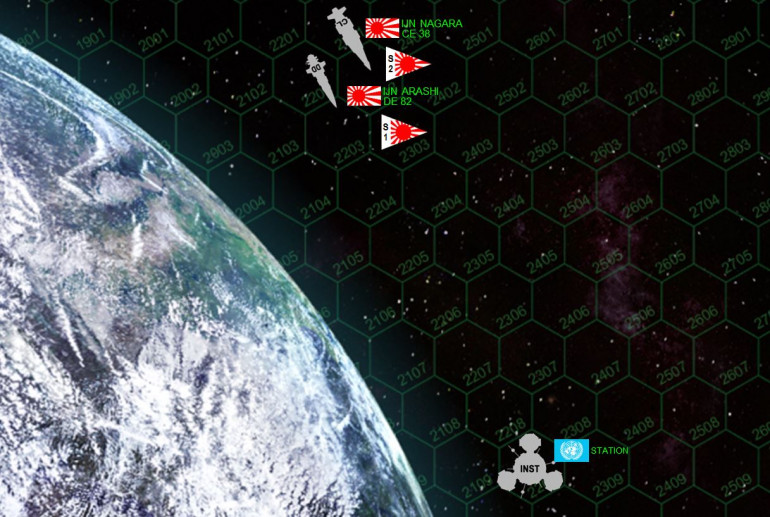 A close up on the Japanese battlegroup. We have the Taiho class light cruiser Nagara and the Takashiro class destroyer Arashi. Both are very fast, bristling with electronics, but also a little fragile.
A close up on the Japanese battlegroup. We have the Taiho class light cruiser Nagara and the Takashiro class destroyer Arashi. Both are very fast, bristling with electronics, but also a little fragile.  The Russian battlegroup is a lot chunkier. By no leans low tech (actually everything here is "standard") - but they have tougher shielding, more harder-hitting guns (just not as accurate) and more torpedoes (again, just nowhere near as fast, accurate, or hard-hitting as those Japanese Class V ... the Ki-45 "Toryu" (Dragon Slayer) torpedoes.
The Russian battlegroup is a lot chunkier. By no leans low tech (actually everything here is "standard") - but they have tougher shielding, more harder-hitting guns (just not as accurate) and more torpedoes (again, just nowhere near as fast, accurate, or hard-hitting as those Japanese Class V ... the Ki-45 "Toryu" (Dragon Slayer) torpedoes.Progress Report - Darkstar Rules
Work continues on the Darkstar rule set. I feel the worst is now behind me. Combat Phase is completely finished. All that remains is . . .
- Resolution Phase
- Ships Crippled
- Ships Exploded
- Ships Breaking off
- Damage Effects
- Scenarios
- (design)
- (scoring)
- Tips
- Designer’s Notes
***
Then 20 or ship classes.
This would turn into 40+ more pages of material
In all this book will be over 80 pages.
20 Ship classes allows me 4 ship classes or so for five factions – definitely a decent start for players who are interested in getting started.
PayPal Contributors Get Their First Warships!
Good afternoon, Beasts of War / OTT!
As I have stated below, I have been so happily surprised by the outpouring of support that people have donated to the ongoing project of an official written and published rules set for Darkstar.
If you are so inclined (I thank you very much in advance), just hit the link below and contribute in whatever amount you feel comfortable.
Meanwhile, here is the list of Darkstar supporters to whom I already owe a fantastic debt of gratitude.
In this vein, I’m happy to roll out the first few ships that people have already “commissioned” to be built or named after them. These are included below. I hope you like them!
Thanks so much again,
Jim “Oriskany” Johnson
The Trafalgar class heavy cruiser represents a radical break from the typical design philosophy and operational doctrine of the Royal Navy. Originally the brainchild of Vice-Admiral Sir Damon Brentnall (battlecruiser squadron commander during the Psi Serpentis War of 2512-14), the Trafalgar design turns its back on the large-caliber rail gun, staple of British naval design for at least the last 70 years. Instead the Trafalgar looks to the relatively new electron particle cannon, perhaps influenced by designs like the American Gettysburg class, Japanese Katana class, and Russian Kutusov class.
In many ways, the Trafalgar is simplicity itself. Packing the newest Harland and Wolff “Quasar Sigma” series reactors and engines (the same type mounted in the successful Iron Duke class), she’s able to generate an enormous power-to-weight ratio for her size, allowing her to keep pace with most light cruiser classes in Known Space. She also carries the same advanced Hawkinge Electronics 01A fire control system, giving her weapons a deadly-accurate reach.
There, however, the similarities end. Whereas Royal Navy heavy cruisers like the Iron Duke or Titan classes are built for firepower, the Trafalgar is built for speed. She sacrifices a fair amount of shielding for this speed, and also carries no torpedoes of any kind. Her secondary battery is also something of a down-step, trading in the British Aerospace Systems 8 MgKv lasers of the Iron Duke for the older, smaller 6 MgKv emitters carried on the Titan class. She also carries smaller 25mm Hispano mass driver arrays, although many more of them.
Notably, the Trafalgar class also carries additional cargo and 54 Royal Marines, which, in addition to her carrying no torpedopes, makes her ideal for longer-ranged, extended war cruises deeper into Second Band conflict zones.
Still, the Trafalgar class packs an enormous punch. Thundering towards the enemy in a high-speed run, these cruisers are designed to unleash a withering EPC broadside, punching deeper through ruined armor and exposed hull compartments with her follow-up laser emitters.
Accordingly, Trafalgar captains are chosen for their aggression and expected to follow Nelson’s mandate of seven hundred years ago; “No captain can do very wrong if he places his ship alongside that of the enemy.” In the officers’ mess on each Trafalgar there is a painting of Nelson, beneath which is the inscription;
“Our country will, I believe, sooner forgive an officer for attacking an enemy than for letting it alone.”
Of course, the Trafalgar class is still very new. Only a few of the ships have traded fire in anger, and there isn’t nearly enough real-combat data to determine whether this design doctrine portends a new outlook for the Royal Navy into the 2520s, or an “evolutionary dead end.”
Ships in Class
C 181 – HMS Trafalgar – 2510, New Londonium Shipyards, Saturn – On Duty
C 182 – HMS Temeraire – 2512, Scapa Flow Orbital, Earth – On Duty
C 183 – HMS Bellerophon – 2513, New Londonium Shipyards, Saturn – On Duty
C 184 – HMS Neptune – 2514, Hypsibius Installation, Omicron Eridani – On Duty
C 185 – HMS Orion – 2516, Scapa Flow Orbital, Earth – On Duty
C 186 – HMS Mars – 2517, Hypsibius Installation, Omicron Eridani – On Duty
C 187 – HMS Thunderer – 2518, New Londonium Shipyards, Saturn – On Duty
C 188 – HMS Ajax – 2519, Hypsibius Installation, Omicron Eridani – Undergoing Trials
C 189 HMS Colossus ???, Scapa Flow Orbital, Earth – Under Construction
C 190 HMS Agamemnon ???, Hypsibius Installation, Omicron Eridani Planned
The Maecenas class is definitely one of the most unusual warships in the Royal Navy, not only in the time of Darkstar but perhaps all of British history. Technically designed off of the basic hull of a Relentless class light cruiser, they are officially classified as “expedition ships,” combining a curious blend of mission profiles. Part gun cruiser, part aerospace carrier, and part planetary assault ship, these are true “jacks of all trades” – multirole platforms of nearly unlimited flexibility.
The name of the class is also unusual, honoring Gaius Maecenas, ancient Roman patron of arts and poetry in the time of Caesar Augustus. While the Royal Navy has often borrowed from Classical Rome for the names of its warships, Maecenas may seems an odd choice until one considers the unusual history of this class.
In the wake of the brutal Psi Serpentis War of 2512-2514, a consortium of British industrialists (brothers Warren and Lloyd Johnston, together with Justin McAuley of Johnston-McAuley Aerospace) in the New Glasgow star system (Psi Serpentis E), were appalled by the war’s violence and collateral damage. They petitioned the Royal Navy to build a new class of multirole “expedition” ships to help protect their industrial facilities, safeguard their shipping lanes, and expand into new colonies for further industrial and economic development. The request was denied, so JMA simply bought the derelict wreck of a Relentless class light cruiser lost in the Psi Serpentis War (HMS Ruthless – C 238 – cost undisclosed, but rumored to be in excess of £2 billion) and rebuilt it into what would become HMS Maecenas. Rather than name the ship after themselves, the executives of JMA named the ship after a famous patron of Classical Rome, as they were also well-known patrons and benefactors of British arts, literature, and science throughout Known Space.
Building a warship on this scale is one thing, but operating and maintaining it for years, with a flotilla of escort ships, is something else. So JMA “donated” the ship (as the famous patrons they were) to the Royal Navy, again petitioning for a class of warships to be designed on this model. Beset with such a gift (along with undisclosed contributions to several key members of Parliament), the Royal Navy this time agreed and the Maecenas class expedition ship was born.
The Maecenas class are truly remarkable warships. A battery of six BAE Systems “Warhammer” class 8-gigawatt rail guns is arrayed in three double turrets, in classic British “Atlantic Pattern” layout. These are comparable in caliber to other light cruisers like the Prussian Hipper class and larger than the 7-gigawatt guns of the Russian Konstantin class and American Sacramento class, but fewer in number. The secondary battery is made up of two double turrets of Harland and Wolff “Nebula” 8-megakelvin laser emitters. A Hawkinge Electronics 01B fire control system is also mounted (a downscaled variant of the model carried on the Iron Duke and Trafalgar heavy cruisers), giving the Maecenas enhanced gunnery accuracy, especially at longer ranges. This also augments the guidance systems of two bays of Model 41 (British standard class IV) gravitic torpedoes, mounted in an “assault configuration” in the port and starboard bow.
For defense, Maecenas class mounts an array of Hispano-Vickers 25mm chain gun mass drivers, and an ECM / gravitic shielding suite comparable to other light cruisers currently in service across Known Space.
But its in the greatly expanded hangar bays that the Maecenas class really stands out. Each cruiser carries eight Supermarine Starfire class aerospace superiority fighters and four Hawker Typhoon class strike bombers, as well as two De Havilland Buccaneer scouts. This is the same complement as carried by the Royal Navy’s Osprey class light carrier. The aft bays carry four Griffon Hoverwork Conqueror class assault boats. The usual mission load out for these assault boats is for one to carry a pair of Excelsior battle tanks, one to carry three Rapier class APCs, and two to carry 48 Royal Marine infantry.
The extra power needed to support such a diverse load of facilities is provided by the very advanced Johnston-McAuley deuterium-tritium reactors and power plant. These are among the most advanced power plants in Known Space, and absolutely critical to the Maecenas multirole platform capability.
The Maecenas class is still very new, and critics are still unconvinced that this unusual design will prove effective. After all, “jack of all trades” also means “master of none.” She can’t stand up to a gunnery duel against other full-design light cruisers like an American San Antonio, Prussian Hipper, Russian Kutusov or Japanese Taihō class. She can’t compete with the aerospace capability of British Valiant class light fleet carriers, or the American Endeavors, Japanese Kagoshimas or Russian Gagarins. She can’t hit a planet nearly as hard as similar-weight dedicated planetary assault ships like the American Saipan class or Prussian Valkyrie class.
But whereas these ships are all built specifically for one role, the Maecenas can perform them all to a remarkable (if partial) extent. This makes them incredibly flexible, operationally perhaps one of the most well-rounded designs in Known Space. They can Darkstar Wave into a new system, establish a colony, and then defend that colony. If resistance is moderate, she can probably eliminate enemy defenses and take an existing colony. While she might have trouble against other cruisers in pitched battle, anything destroyer-sized or smaller would do well to approach a Maecenas with no small amount of caution.
In the end, however, only time will tell whether these innovative “expedition” ships will find a role, and widespread success in Royal Navy service.
** The ships of the Maecenas class are actually named for OTT/BoW community members who have donated to the writing of the Darkstar Rules Set v 1.0 or contributed materially in some way to the success of the project.
** Note that the ship design tables include double the extra available power conferred by the “advanced powerplant” feature. All the additional power this confers is invested in the assault boat / ground troops package, which isn’t used in the vast majority of games. If the Maecenas class is being used in a planetary assault scenario, or if the assault boats are removed for more fighters and bombers, the scenario cost of the ship increases to 107 points.
Ships in Class
C 261 – HMS Maecenas – 2514, JMA Shipyards, Psi Serpentis E – On Duty
C 262 – HMS Quin – 2516, Scapa Flow Orbital, Earth – On Duty
C 263 – HMS Wood – 2516, Hypsibius Installation, Omicron Eridani – On Duty
C 264 – HMS Lea – 2517, Scapa Flow Orbital, Earth – On Duty
C 265 – HMS Shaw – 2518, New Londonium Shipyards, Saturn – On Duty
C 266 – HMS Petersen – 2519, Scapa Flow Orbital, Earth – On Duty
C 267 – HMS Oberst – 2520, Hypsibius Installation, Omicron Eridani – Undergoing Trials
C 268 – HMS Hawes – 2521, New Londonium Shipyards, Saturn – Under Construction
C 269 – HMS ??? – ??? Scapa Flow Orbital, Earth – Planned
Darkstar Online - Oriskany vs. Davehawes (Part IV)
The Darkstar battle between myself and @davehawes . . . the first translatlantic Darkstar game run on-line via web conference . . . concludes.
When we left off, this hard-fought battle was at last boiling down to a sizzling and tense finale. One way or another, both my cruiser battlegroup of the Holy Russian Empire and Dave’s light aerospace group were rapidly reaching different breaking points. So far, the British and Russians have traded frigates, each knocking out the other’s smallest escort ships straight away (HMS Fergusson and CPK Volkhov). A massive British torpedo spread and aerospace bomber and fighter strike launched off the light carrier HMS Raven heavily damaged my flagship Basilov (an aging Konstantine class light cruiser), while my much heavier guns (I have no real aerospace group of my own) hammered the sleek, advance Falkands class destroyer HMS Singapore. After taking 50% losses among their fighters and bombers, the British were able to finally cripple the Basilov, but not before her 7-gigawatt rail guns and P-500 “Plamya” torpedoes savaged the Singapore. Both ships are left burning and adrift in space, leaving only the British light carrier HMS Raven and the Russian gun destroyer Kortik (Sonvya class).
The question is, can my guns overcome British aerospace superiority?
Short answer, hell yes. Dave has already lost two of his bombers and four or his fighters, a full half of his aerospace strike group. He hasn’t been able to land his remaining two bombers yet, the Raven keeps accelerating out of their reach in order to keep my guns at maximum distance. To make matters worse, Raven is almost out of torpedoes. Her bow tubes are now empty, she has one more spread left in her aft tubes and then that’s it.
I should have this game in the bag, to be honest, except for one thing. On Turn 3, the Singapore’s last volley of 8 megakelvin lasers hither port quarter perfectly, both digging into the exact same place just deep enough to knock out my shields port quarter shields.
So as the Raven continues to pull away (she is a aerospace craft carrier, after all, she has no business closing to gunnery range of a heavy Russian destroyer), I have the Kortik accelerate into a port turn away from the planet, rolling her over in an attempt to screen my unshielded port quarter.
Here we see the fateful moment. These six blue torpedoes are almost the last warheads Raven can launch at me. Her four fighters are also coming in. I have to shoot my mass drivers at the torpedoes to thin them out, Dave has the range to send these torpedoes around my ship to hit her in the unshielded port quarter (along with four fighters on gunnery strafing runs). I won’t lie, this attack will be chancy, not having that port quarter shield is terribly worrisome. But the odds are with me, and if I can just survive this last torpedo spread, I’m 95% sure to squeak out a win.
Meanwhile, my torpedoes are racing in against the Raven. I’ll also be unloading a pretty serious broadside on her, although Dave has carefully maneuvered his ship to a range of 11 hexes. This is just far enough to drop my chance to hit against his shields from a 4 to a 3. Also, Kortik may be a fearsome destroyer, but she’s just a destroyer all the same. Still, this is only Turn 4. And if she survives that torpedo spread, I can hit HMS Raven again on Turn 5, and Turn 6, and Turn 7, and Turn 8 . . . until she’s crippled or leaves the battle area. Either way, I win.
Note HMS Singapore soaring by at a speed of 21 kilometer per second, trailing a sheet of burning atmosphere. Also, the derelict Volkhov is spinning out of control, threading the needle between those debris asteroids on her way out into deep interplanetary space, probably launching lifeboats and rescue beacons.
I’m not gonna lie, the British do really well here . . . and just like that, the game turns. Here is the WRS for the destroyer Kortik. Yellow is the damage done in previous turns, you can see where HMS Singapore took out Kortik’s port quarter shields. Okay, I shot down five of his six torpedoes (good roll on the mass driver table), leaving only one torpedo left. His four fighters scored two confirmed hits, but these wound up landing too far forward (column 1). So it’s literally down to that last torpedo.
It will almost certainly hit, as this part of my ship has no shielding. Sure enough, it hits.
But where? Sure, he might knock down Crew Facilities, Maneuvering Thrusters, etc . . .
Or he could roll a 4 on his d4 for hit location, sailing the torpedo right down the hole where his two lasers hit last turn. The warhead explodes inside my Aft Weapons compartment, cavitating through both reactor rooms and down into the starboard engine.
How lucky was that? I’ve now lost three critical boxes, reducing my 7+ cripple target for a destroyer to a 4+. So Dave has to roll 4+ on a d6, it’s literally a 50/50 chance.
He rolls a 5. The Kortik is crippled . . . and that’s game.
Now technically the Kortic gets its return fire on the Raven. But Raven’s mass drivers and scouts have shot down all my torpedoes, and my guns can’t do this much in one turn against brand new armor. I scratch the paint a little, but that’s about it.
So the British have the HMS Raven still operational (20 points), 2 bombers and 4 fighters (12 points) and 5 scouts (5 points) for a total score of 37. I have 1 point (1 scout). A +36 point win = 31.6% margin of a 117-point game, giving the British a solid (but minor) victory (40% is required for a “major” victory in campaign point terms).
In all, I feel this experiment was a success. I might redesign some of the playing pieces, particularly for torpedoes and aerospace craft, just to make them a little easier to handle especially for a remote player. But in all this game shook out pretty well. The margin in points seems a little high, but carefully looking at the actual course of events shows that if Kortik had survived that last torpedo hit (odds were only 25% it would hit in that vulnerable location, then a 50% roll for survival, yielding an aggregate 12.5% chance of being knocked out . . . and she was) – she would have been able to pepper the Raven for the rest of the game with near impunity. It would have been a “soggy” end, but almost certainly a Russian win.
As a designer, any time the game comes close (especially for a new player). I’m happy.
So that wraps up this game. Next I’ll be rolling out some of the ships requested by people who’ve been supporting my PayPal donation pool for the Darkstar rules set.
And yes, still chipping away on those rules. All “to hit” procedures are done, illustrated, etc., I’m now stuck deep into applying damage. After that it’s just Resolution Phase, a few notes on constructing and scoring scenarios, and rules are done! Then comes the fun part, chewing through 20 or so of my favorite classes, making sure at least five or so of these factions are well represented.
Hope you liked the battle report! And please pass your congrats to @davehawes for not only taking the plunge and playing Darkstar, but being the first to do it online, and having the guts to start his Darkstar play with the extra complexity of an aerospace carrier!
Darkstar Online - Oriskany vs. Davehawes (Part III)
The Darkstar battle between myself and community member @davehawes – played online on Saturday, December 1, continues.
So we’ve seen where my cruiser battlegroup of the Holy Russian Empire and Dave’s aerospace carrier battlegroup of the Royal Navy have been slugging it out so far. Each battlegroup has lost its frigate, my CPK Volkhov crippled by a long-range x-ray laser that cut through my portside reactors, and his HMS Fergusson that took a 7-GW rail gun through the bridge.
Meanwhile, my flagship (Konstantine class light cruiser CPK Basilov) has been heavily mauled by British aerospace torpedoes, missiles, and gravitic torpedoes launched from HMS Raven and the destroyer HMS Singapore, losing her starboard side engines and taking damage all the way up into her aft hangars (Oh no, the captain’s yacht was just taken out)!
At the same time, I’ve managed to land some P-500 “Plamya” (Flame) torpedo hits on the fantail of the Singapore, missing her engines unfortunately not taking out some of her sensors and aft mass drivers.
Now we’re looking at the movement phase of Turn 3, where I’ve dove toward the planet in an attempt to screen myself, or at least remove a little of Dave’s freedom to maneuver his fighters and torpedoes. It’s not going to work, as his eight fighters and a full torpedo spread head toward Basilov’s damaged fantail. My mass drivers have already smacked down four of his eight fighters, but the four that are left are ready to start a “Star Wars-style” strafing run on my damaged ship. Meanwhile, my gunners are lining up a second broadside on HMS Singapore, while the remaining two bombers of HMS Osprey can’t quite catch up to their accelerating carrier to land! Hey, wait for us!
So like I said, I have shot down four Supermarine Starfires, saving the rest of my mass drivers for shooting down the torpedoes. But the Basilov has damaged sensors, don’t forget. Still, the destroyer CPK Kortik is able to knock down some torpedoes as well. Not nearly enough, however . . .
Meanwhile, my own torpedo spread is streaking in on the damaged stern of the Singapore. That destroyer has also taken sensor damage, while the HMS Raven tries to help as well, as well as five British scouts shooting down some more torpedoes. The real threat, however, is the broadside from the 7GW rail guns of the Basilov. The range is 1800 kilometers, perfect for this caliber of gun.
Very bad news for the HMS Singapore. Out of my ten torpedoes, only two survive mass driver fire, scout intercepts, and shields, but they hit the fantail hard. The purple boxes show their impact points, the cavitation damage extends forward through compartments of the ship. Starboard engines take a hit! The second torpedo hits the aft cargo bay, exploding forward and smashing out the destroyer’s aft syglex emitter, the whole weapons turret blown off the ship and into space!
But the real damage comes from the double broadside delivered from the destroyer Kortik and the light cruiser Basilov. One of the Basilov’s plasma projectors hits in Column 1 (green box) spreading left and right (fore and aft) like a flamethrower. With this armor this shallowed, I then follow up with a hammering of five rail-gun hits (three from the Basilov, two from the Kortik – red impact points). These drill deep into the Singapore’s starboard quarter, knocking out more sensors, maneuvering thrusters, the troop bay (half the marines are probably killed, wounded, or trying to put out fires). I then hit the starboard side reactors, the blast carrying through into portside reactors as well.
So three critical (red) boxes of the ship have been hit. Destroyers have a 7+ target to cripple, -3 crit boxes hit = a chance of 4+. I roll a 6, and the HMS Singapore loses power, adrift and dead in space.
This moment of Russian victory is short lived, however. Even as the Singapore is being hammered, so is the Basilov. The first attack to hit are the those four fighters on a gunnery run. Despite my shields (still up, amazingly), they score one hit that happens to hand on my med bay! So my casualties from engineering have made it to med bay only to be machine-gunned by British fighters!
That’s a war crime, Dave! You can bet I’ll be contacting the Hague about that!
Far worse is yet to come. Four gravitic torpedoes (all from HMS Raven) hit on the red-colored boxes. Aft shields finally die, aft mass drivers are knocked out, portside reactors are gone, portside reactors take a hit. Cavitation damage ripples forward through the ship. Finally comes a torpedo hit again in MED BAY! The blast tears up through the center of the ship, damaging (but not destroying) the bridge, then setting off an explosion in the forward magazine!
Eight critical boxes have now been hit. The Target to Cripple a light cruiser is 10+, -8 crit boxes = a 2+ roll on a d6. It’s a pretty easy roll, which Dave makes with no problem. The Basilov is crippled. Even if she wasn’t, this ship would now be at 60% thrust, -1 from initiative for the bridge hit (for a net penalty of -3 on initiative), -1 to hit, -1 mass driver bracket, no aft shields, 75% chance for a forced break off . . .
In all, 31 days will be needed to bring this ship back, that’s after she’s towed back to a base, assuming she makes her ship recover check at all . . .
Still more bad news is to come. The Singpore’s last volley scores two powerful 8 MgKv laser hits on the port quarter of the destroyer Kortik, then Dave rolls very well on his hit location, and actually knocks down the port quarter shields.
Here we are at the end of movement of Turn 4. The Basilov, Singapore, Fergusson, and Volkhov are all adrift, careening through space at their last powered heading and velocity. You can see why it’s so important that you never end your turn facing toward a planet, moon, or asteroid. You can see where my last ship, the destroyer Kortik, is now inverted, trying to hide her damaged (and unshielded) port quarter from the British. Hiding it from the HMS Raven is easy enough, hiding it from the torpedoes and remaining fighters is not.
However, those disabled shields are really the result of some very lucky shooting from a ship that is no longer operational. If I can knock down enough of these torpedoes, the ones that hit will probably not do enough damage to cripple the Kortik outright. Meanwhile, these are practically the last torpedoes the Raven has. Half her bombers are shot down, the two that are left still haven’t been able to land to rearm. Four fighters are gone. My guns meanwhile, can shoot all day . . .
Believe it or not, the British, particularly the HMS Raven, are actually in a spot of trouble here . . .

































